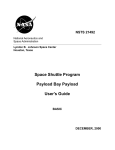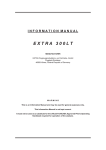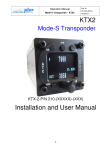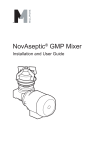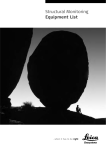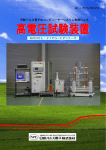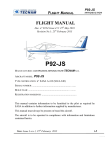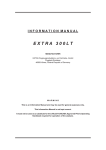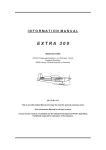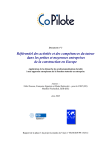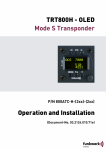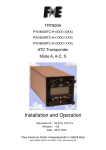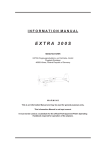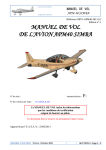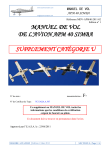Download Airplane Flight Manual XA42
Transcript
Airplane Flight Manual XA42 S/N: Manufacturer: _________________ XtremeAir GmbH Harzstraße 2 Registration: Am Flughafen Cochstedt ___________________ 39444 Hecklingen Document Number: Germany AFM-XA42-0040-002-A.01 This Manual includes the material required to be furnished to the pilot by EASA regulations and additional informations provided by the manufacturer and constitutes the EASA approved Flight Manual. This Flight Manual is EASA approved under Approval Number A.507 _______________________ EASA certification manager Cover Airplane Flight Manual XA42 AFM-XA42-0040-002-A.01 Intentionally left blank Page I Page date: 24.01.2011 Airplane Flight Manual XA42 AFM-XA42-0040-002-A.01 LOG OF REVISIONS Issue Date A.01 27.01.2011 Page date: 24.01.2011 Approved Page II Airplane Flight Manual XA42 AFM-XA42-0040-002-A.01 LOG OF EFFECTIVE PAGES Issue Cover and l A.01 II and III A.01 lV and V A.01 VI and VII A.01 Vlll and Chapter 01, Page 1 A.01 Chapter 01, Page 2 and Chapter 01, Page 3 A.01 Chapter 01, Page 4 and Chapter 01, Page 5 A.01 Chapter 01, Page 6 and Chapter 01, Page 7 A.01 Chapter 01, Page 8 and Chapter 02, Page 1 A.01 Chapter 02, Page 2 and Chapter 02, Page 3 A.01 Chapter 02, Page 4 and Chapter 02, Page 5 A.01 Chapter 02, Page 6 and Chapter 02, Page 7 A.01 Chapter 02, Page 8 and Chapter 02, Page 9 A.01 Chapter 02, Page 10 and Chapter 02, Page 11 A.01 Chapter 02, Page 12 and Chapter 03, Page 1 A.01 Chapter 03, Page 2 and Chapter 03, Page 3 A.01 Chapter 03, Page 4 and Chapter 03, Page 5 A.01 Chapter 03, Page 6 and Chapter 03, Page 7 A.01 Chapter 03, Page 8 and Chapter 04, Page 1 A.01 Chapter 04, Page 2 and Chapter 04, Page 3 A.01 Chapter 04, Page 4 and Chapter 04, Page 5 A.01 Chapter 04, Page 6 and Chapter 04, Page 7 A.01 Chapter 04, Page 8 and Chapter 04, Page 9 A.01 Chapter 04, Page 10 and Chapter 04, Page 11 A.01 Chapter 04, Page 12 and Chapter 05, Page 1 A.01 Chapter 05, Page 2 and Chapter 05, Page 3 A.01 Chapter 05, Page 4 and Chapter 05, Page 5 A.01 Chapter 05, Page 6 and Chapter 05, Page 7 A.01 Chapter 05, Page 8 and Chapter 05, Page 9 A.01 Chapter 06, Page 1 and Chapter 05, Page 2 A.01 Chapter 06, Page 3 and Chapter 06, Page 4 A.01 Chapter 06, Page 5 and Chapter 06, Page 6 A.01 Chapter 06, Page 7 and Chapter 07, Page 1 A.01 Chapter 07, Page 2 and Chapter 07, Page 3 A.01 Chapter 07, Page 4 and Chapter 07, Page 5 A.01 Chapter 07, Page 6 and Chapter 07, Page 7 A.01 Chapter 07, Page 8 and Chapter 07, Page 9 A.01 Chapter 07, Page 10 and Chapter 07, Page 11 A.01 Chapter 08, Page 1 and Chapter 08, Page 2 A.01 Chapter 08, Page 3 A.01 Page date: 24.01.2011 Page III Airplane Flight Manual XA42 AFM-XA42-0040-002-A.01 TABLE OF CONTENTS LOG OF REVISIONS ........................................................................................................... II LOG OF EFFECTIVE PAGES................................................................................................ III TABEL OF CONTENTS ......................................................................................................... IV INTRODUCTION ................................................................................................................ VI NOTES ................................................................................................................................ VI WARNINGS; CAUTIONS AND NOTES ............................................................................... VII 1 1.1 1.2 1.3 1.4 1.5 1.6 1.7 1.8 1.9 1.10 1.11 1.12 1.13 2 2.1 2.2 2.3 2.4 2.5 2.6 2.7 2.8 2.9 2.10 2.11 2.12 2.13 2.14 2.15 2.16 2.17 3 3.1 3.2 3.3 3.4 3.5 3.6 3.7 3.8 3.9 3.10 3.11 4 4.1 4.2 Page GENERAL .......................................................................................................... 1-01 DESCRIPTION .......................................................................................................... 1-01 SPECIICATION OF CATEGORY .................................................................................. 1-01 MANUFACTURER ...................................................................................................... 1-01 TECHNICAL DATA .................................................................................................... 2-01 ENGINE ................................................................................................................... 4-01 PROPELLER ............................................................................................................. 4-01 EXHAUST SYSTEM.................................................................................................... 4-01 FUEL ....................................................................................................................... 4-01 OIL ......................................................................................................................... 5-01 SMOKE OIL .............................................................................................................. 5-01 LOADING ................................................................................................................. 5-01 TERMINOLOGY ........................................................................................................ 5-01 CONVERSION TABLE ................................................................................................ 7-01 LIMITATIONS................................................................................................... 1-02 GENERAL ................................................................................................................. 1-02 AIRSPEED (IAS) ....................................................................................................... 1-02 CROSSWIND COMPONENT ....................................................................................... 1-02 ENGINE ................................................................................................................... 2-02 PROPELLER ............................................................................................................. 3-02 WEIGHT LIMITS....................................................................................................... 3-02 WEIGHT AND CENTER OF GRAVITY ENVELOPE ......................................................... 3-02 BAGGAGE ................................................................................................................ 3-02 ACROBATIC MANEUVERS ......................................................................................... 4-02 LOAD FACTORS ....................................................................................................... 5-02 FLIGHT CREW LIMITS .............................................................................................. 6-02 KINDS OF OPERATIONAL LIMITS .............................................................................. 6-02 MAXIMUM OPERATING ALTITUDE ............................................................................. 6-02 TYRE PRESSURE ...................................................................................................... 6-02 SMOKE OIL .............................................................................................................. 6-02 MARKINGS AND PLACARDS ...................................................................................... 6-02 KINDS OF OPERATION EQUIPMENT LIST .................................................................10-02 EMERGENCY PROCEDURES.............................................................................. 1-03 INTRODUCTION ....................................................................................................... 1-03 AIR SPEEDS FOR EMERGENCY OPERATION ............................................................... 2-03 OPERATIONAL CHECKLIST ....................................................................................... 2-03 FORCED LANDINGS .................................................................................................. 4-03 FIRES ...................................................................................................................... 5-03 ICING – INADVERTENT ENCOUNTER ........................................................................ 5-03 UNITENTIONAL SPIN ............................................................................................... 6-03 BAIL-OUT ................................................................................................................ 6-03 EMERGENCY EXIT AFTER FLIP-OVER ........................................................................ 6-03 ELEVATOR CONTROL FAILURE ................................................................................. 6-03 LIGHTNING STRIKE ................................................................................................. 7-03 NORMAL PROCEDURES .................................................................................... 1-04 GENERAL ................................................................................................................. 1-04 PREFLIGHT INSPECTION .......................................................................................... 1-04 IV Page date: 24.01.2011 Airplane Flight Manual XA42 AFM-XA42-0040-002-A.01 4.3 4.4 4.5 4.6 4.7 4.8 4.9 4.10 4.11 4.12 5 5.1 5.2 5.3 5.4 5.5 5.6 5.7 5.8 6 6.1 6.2 6.3 6.4 6.5 6.6 7 7.1 7.2 7.3 7.4 7.5 7.6 7.7 7.8 7.9 7.10 7.11 7.12 7.13 7.14 7.15 7.16 8 8.1 8.2 8.3 8.4 8.5 8.6 8.7 CHECKLIST PROCEDURES ........................................................................................ 2-04 STARTING PROCEDURES .......................................................................................... 5-04 TAXIING THE AIRCRAFT ........................................................................................... 5-04 TAKE-OFF PROCEDURES .......................................................................................... 6-04 CLIMB ..................................................................................................................... 7-04 CRUISE ................................................................................................................... 7-04 LANDING PROCEDURES ........................................................................................... 7-04 SHUTDOWN ............................................................................................................. 8-04 AFTER LEAVING THE AIRCRAFT................................................................................ 9-04 ACROBATIC MANEUVERS ......................................................................................... 9-04 PERFORMANCE ................................................................................................ 1-05 GENERAL ................................................................................................................. 1-05 ISA CONVERSION .................................................................................................... 2-05 AIRSPEED CALIBRATION .......................................................................................... 3-05 STALL SPEED ........................................................................................................... 3-05 TAKE-OFF PERFORMANCE ........................................................................................ 4-05 RATE OF CLIMB PERFORMANCE................................................................................ 6-05 CRUISE PERFORMANCE, RANGE, ENDURANCE AND FUEL CONSUMTION..................... 6-05 LANDING PERFORMANCE ......................................................................................... 7-05 WEIGHT & BALANCE ........................................................................................ 1-06 GENERAL ................................................................................................................. 1-06 AIRCRAFT WEIGHING PROCEDURE ........................................................................... 1-06 CENTER OF GRAVITY CALCULATION (SAMPLE) ......................................................... 2-06 LOADING WEIGHTS AND MOMENTS ......................................................................... 3-06 WEIGHTS AND MOMENTS LIMITS ............................................................................. 4-06 EUIPMENT LIST XA42 S/N:101.................................................................................. 5-06 DESCRIPTION AND OPERATION OF AIRCRAFT AND SYSTEMS ....................... 1-07 AIRCRAFT ................................................................................................................ 1-07 FUSELAGE ............................................................................................................... 1-07 WING ...................................................................................................................... 1-07 EMPENNAGE ............................................................................................................ 2-07 FLIGHT CONTROL SYSTEM ....................................................................................... 2-07 INSTRUMENTATION ................................................................................................. 3-07 LANDING GEAR ........................................................................................................ 5-07 SEAT AND SEATBELTS ............................................................................................. 5-07 CANOPY .................................................................................................................. 6-07 POWER PLANT ......................................................................................................... 6-07 FUEL SYSTEM .......................................................................................................... 8-07 ELECTRICAL SYSTEM ............................................................................................... 9-07 CABIN ENVIRONMENT CONTROL .............................................................................. 9-07 BAGGAGE COMPARTMENT .......................................................................................10-07 PITOT - STATIC SYSTEM .........................................................................................10-07 SMOKE SYSTEM ......................................................................................................10-07 HANDLING, SERVICING AND MAINTENANCE ................................................. 1-08 INTRODUCTION ....................................................................................................... 1-08 AIRPLANE INSPECTION PERIODS ............................................................................. 1-08 PILOT CONDUCTED PREVENTIVE MAINTENANCE ...................................................... 1-08 ALTERATIONS OR REPAIR ........................................................................................ 1-08 SERVICING .............................................................................................................. 1-08 GOUND HANDLING .................................................................................................. 2-08 CLEANING AND PROTECTION ................................................................................... 2-08 Page date: 24.01.2011 Page V Airplane Flight Manual XA42 AFM-XA42-0040-002-A.01 INTRODUCTION This Airplane Flight Manual contains 9 chapters, and includes the material required to be known by the pilot according to EASA CS-23. It also contains supplementary data supplied by XtremeAir GmbH. NOTES This Airplane Flight Manual applies only to the aircraft whose nationality and registration marks are noted on the title page. This Airplane Flight Manual is only valid in connection with the latest approved revision. It is the responsibility of the pilot to be familiar with the contents of this Airplane Flight Manual including revisions and any relevant supplements. Pages of this Airplane Flight Manual must not be exchanged and no alterations of or additions to the approved contents may be made without the XtremeAir GmbH/EASA approval. The editor has the copyright of this Airplane Flight Manual and is responsible for edition of revisions/amendments and supplements. Amendments, which affect the airworthiness of the aircraft will be announced in the mandatory Service Bulletins issued by the manufacturer XtremeAir GmbH coming along with the "Airworthiness Directive" (AD) publication issued by the EASA. The owner is responsible for incorporating prescribed amendments and should make notes about these on the records of amendments Should this Airplane Flight Manual get lost, please inform XtremeAir GmbH, Harzstraße 2, Am Flughafen Cochstedt, 39444 Hecklingen, Germany. Should this Airplane Flight Manual be found, kindly forward it to the civil aviation authority in the country the aircraft is registered. Page date: 24.01.2011 Page VI Airplane Flight Manual XA42 AFM-XA42-0040-002-A.01 WARNINGS, CAUTIONS AND NOTES The following definitions apply to Warnings, Cautions, and Notes: WARNING Operating procedures, techniques, etc., which could result in personal injury or loss of life if not carefully followed. CAUTION Operating procedures, techniques, etc., which could result in damage to equipment if not carefully followed. NOTE Operating procedures, techniques, etc., which are considered essential to emphasize. Page VII Page date: 24.01.2011 Airplane Flight Manual XA42 AFM-XA42-0040-002-A.01 Intentionally left blank Page date: 24.01.2011 Page VIII Airplane Flight Manual XA42 AFM-XA42-0040-002-A.01 1. GENERAL 1.1 DESCRIPTION The XA42 is a two-seat, high performance acrobatic tailwheel airplane. The structure is manufactured from carbon/honeycomb sandwich. 1.2 SPECIFICATION OF CATEGORY The aircraft is certified in the Utility and Acrobatic category according to EASA CS-23. EASA type certificate data sheet A.507 1.3 MANUFACTURER XtremeAir GmbH Harzstraße 2, Am Flughafen Cochstedt 39444 Hecklingen Germany Page 1 Chapter 01 Page date: 09.11.2010 Airplane Flight Manual XA42 AFM-XA42-0040-002-A.01 1.4 TECHNICAL DATA 1.4.1 3 VIEW DRAWING All dimensions in millimeters Page date: 24.01.2011 Page 2 Chapter 01 Airplane Flight Manual XA42 AFM-XA42-0040-002-A.01 1.4.2 MAIN DATA Length overall 6670 mm Height overall (ground attitude) 2542 mm Span 7500 mm Wheel base 4425 mm Wheel track 2000 mm 1.4.3 WING Wing plan form Trapezoid Wing span 7500 mm Wing area 11.25 m² Aspect ratio 5.00 Airfoil PS-1-16 / Tip PS-1-09 Root chord 2060 mm Tip chord 950 mm MAC 1505 mm Aileron span 3220 mm Aileron area 1.26 m² Aileron deflection ± 30 ° 1.4.4 HORIZONTAL TAIL (INCLUDING ELEVATOR) Plan form Trapezoid Span 2600 mm Area 2.97 m² Airfoil DU86-MOD1 1.4.5 ELEVATOR Span 3200 mm Area 1.45 m² Deflection ± 27 ° 1.4.6 FLETTNER TAB Span: 400 mm Tip chord: 130 mm Deflection: ± 30 ° Page 3 Chapter 01 Page date: 24.01.2011 Airplane Flight Manual XA42 AFM-XA42-0040-002-A.01 1.4.7 VERTICAL TAIL (INCLUDING RUDDER) Plan form: Trapezoid Height: 1100 mm Area: 1.54 m² Airfoil: DU86-MOD1 1.4.8 RUDDER Height: 1400 mm Area: 0.82 m² Deflection: ± 30 ° 1.5 ENGINE Manufacturer: Lycoming Engines, Williamsport, PA 17701, USA Type: AEIO-580-B1A Rated power: Acrobatic: 235 kW / 315 hp @ 2700 rpm Rated power: Utility: 233 kW / 312 hp @ 2670 rpm 1.6 PROPELLER Manufacturer: MT-Propeller Entwicklung GmbH, 94348 Atting, Germany Type: MTV-9-B-C/C203-20d 1.7 EXHAUST SYSTEM Manufacturer: Gomolzig GmbH, Eisenwerkstraße 9, 58332 Schwelm, Germany Type: 3 in 1 each side 1.8 FUEL Fuel type: Aviation Gasoline (Avgas) 100LL For alternative fuel grades see latest issue of Textron Lycoming S.I. No. 1070 Minimum / Maximum 100/130 octane Total fuel capacity: 275 l / 72.5 US gal • Wing tanks: 2 x 105 l / 2 x 27.7 US gal • Acro tank: 65 l / 17.1 US gal Usable fuel capacity (Total): 273 l / 72.0 US gal Usable fuel capacity (Acro): 64 l / 16.9 US gal Page 4 Chapter 01 Page date: 24.01.2011 Airplane Flight Manual XA42 AFM-XA42-0040-002-A.01 1.9 OIL Maximum sump capacity: 15.15 l / 16 US qt Minimum sump capacity: 8.52 l / 9 US qt Average Ambient Air Temp. Mil-L6082 grades Mil-22851 ashless dispersant grades All temperatures --- SAE 15W50 or 20W50 > 27°C (80°F) SAE 60 SAE 60 > 16°C (60°F) SAE 50 SAE 40 or SAE 60 -1°C to 32°C (30°F to 90°F) SAE 40 SAE 40 -18°C to 21°C (0°F to 70°F SAE 30 SAE 30, SE 40 or 20W50 -18°C to 32°C (0°F to 90°F) SAE 20W50 SAE 20W50 or SAE 15W50 < -12°C (10°F) SAE 20 SAE 30 or 20W30 Single or multi-viscosity aviation grade oils see latest issue of Textron Lycoming S.I. No. 1014 1.10 SMOKE OIL Smoke Oil type: Straight paraffin oil, viscosity 30-50 cts at 20°C (68°F), initial boiling point > 330°C (626°F) For example: Fauth FC05, Texaco Canopus 13 or equivalent. Total Smoke Oil capacity: 1.11 LOADING -2 Wing Loading kg / m Power – Weight Ratio kg / hp-1 1.12 28 l / 7.4 US gal Utility Category Acrobatic Category 84.4 3.01 75.5 2.69 TERMINOLOGY Air Speeds CAS IAS KIAS TAS VA VNE VNO VS VX VY Calibrated air speed (CAS = TAS in standard atmospheric conditions at sea level) Indicated air speed Indicated air speed in knots True air speed (same as CAS compensated for altitude, temperature and density) Maneuvering speed Never exceed speed Maximum structural cruising speed Stalling speed / minimum steady flight speed Best angle-of-climb speed Best rate-of-climb speed Meteorological Terminology ISA OAT Page date: 24.01.2011 International standard atmospheric condition Outside air temperature Page Chapter 5 01 Airplane Flight Manual XA42 AFM-XA42-0040-002-A.01 Secondary Terminology fpm ft in m l US gal US quartt hp h kts km/h lbs MP NM rpm CG Arm Moment SL Page date: 24.01.2011 Feet per minute Feet (1 ft = 304.8 mm) Inch (1 in = 25.4 mm) Meter Liter US (liquid) gallon (1 US gal = 3.79 Liter) US (liquid) quart (1 US qt = 0.946 Liter) Horse power (English) Hour Knots (nautical miles per hour) Kilometer per hour English pound (1 lbs = 0.4536 kg) Manifold pressure Nautical mile (1 nm = 1.852 km) Revolutions per minute Center of gravity Is the horizontal distance from reference datum Is the product of the weight of an item multiplied by its arm Sea level Page 6 Chapter 01 Airplane Flight Manual XA42 AFM-XA42-0040-002-A.01 1.13 kts 50 55 60 65 70 75 80 85 90 95 100 105 110 115 120 125 130 135 140 145 150 155 160 165 170 175 180 185 190 195 200 205 210 215 220 225 230 235 CONERVERSION TABLE km/h 93 102 111 120 130 139 148 157 167 176 185 194 204 213 222 232 241 250 259 269 278 287 296 306 315 324 333 343 352 361 370 380 389 398 407 417 426 435 Page 7 Chapter 01 km/h 90 100 110 120 130 140 150 160 170 180 190 200 210 220 230 240 250 260 270 280 290 300 310 320 330 340 350 360 370 380 390 400 410 420 430 440 450 460 kts 49 54 59 65 70 76 81 86 92 97 103 108 113 119 124 130 135 140 146 151 157 162 167 173 178 184 189 194 200 205 211 216 221 227 232 238 243 248 ft 500 1000 1500 2000 2500 3000 3500 4000 4500 5000 5500 6000 6500 7000 7500 8000 8500 9000 9500 10000 10500 11000 11500 12000 12500 13000 13500 14000 14500 15000 15500 16000 16500 17000 17500 18000 18500 19000 m 152 305 457 610 762 914 1067 1219 1372 1524 1676 1829 1981 2134 2286 2438 2591 2743 2896 3048 3200 3353 3505 3658 3810 3962 4115 4267 4420 4572 4724 4877 5029 5182 5334 5486 5639 5791 m 250 375 500 625 750 875 1000 1125 1250 1375 1500 1625 1750 1875 2000 2125 2250 2375 2500 2625 2750 2875 3000 3125 3250 3375 3500 3625 3750 3875 4000 4125 4250 4375 4500 4625 4750 4875 ft 820 1230 1640 2051 2461 2871 3281 3691 4101 4511 4921 5331 5741 6152 6562 6972 7382 7792 8202 8612 9022 9432 9843 10253 10663 11073 11483 11893 12303 12713 13123 13533 13944 14354 14764 15174 15584 15994 nm 10 20 30 40 50 60 70 80 90 100 110 120 130 140 150 160 170 180 190 200 220 240 260 280 300 320 340 360 380 400 420 440 460 480 500 520 540 560 km 19 37 56 74 93 111 130 148 167 185 204 222 241 259 278 296 315 333 352 370 407 444 482 519 556 593 630 667 704 741 778 815 852 889 926 963 1000 1037 km 10 20 30 40 50 60 70 80 90 100 110 120 130 140 150 160 170 180 190 200 250 300 350 400 450 500 550 600 650 700 750 800 850 900 950 1000 1050 1100 nm 5 11 16 22 27 32 38 43 49 54 59 65 70 76 81 86 92 97 103 108 135 162 189 216 243 270 297 324 351 378 405 432 459 486 513 540 567 594 Page date: 24.01.2011 Airplane Flight Manual XA42 AFM-XA42-0040-002-A.01 Intentionally left blank Page date: 24.01.2011 Page 8 Chapter 01 Airplane Flight Manual XA42 AFM-XA42-0040-002-A.01 2. LIMITATIONS 2.1 GENERAL This chapter includes limitations for operation of the aircraft, the engine, the standard systems and the standard equipment. Also it gives information on the instrument markings and basic placards. The limitations in this chapter have been approved by the EASA. Observance of these operating limitations is required by national aviation regulations. NOTE In case of an XA42 is equipped with specific options additional information required for safe operation will be contained in chapter 9. Instrument markings and placards are provided for the acrobatic category only; for utility category refer to corresponding limitations. This aircraft is certified under Type Certification Data Sheet EASA.A.507. Any exceedance of given limitations has to be reported by the pilot so that necessary inspection or maintenance procedures according to the maintenance manual can be performed. 2.2 AIRSPEED (IAS) Never exceed speed: VNE 225 kts Maximum structural cruising speed: VNO 185 kts Maneuvering speed: VA 174 kts Maximum operating maneuvering speed Vo 174 KIAS 2.3 CROSSWIND COMPONENT The maximum demonstrated crosswind component for take-off and landing is 25 kts / 47 km/h. 2.4 ENGINE Engine type is Lycoming AEIO-580-B1A with a rated power of 235 kW / 315 hp @ 2700 rpm. 2.4.1 FUEL Minimum grade aviation gasoline: 100LL (for alternate fuel grades see latest revisions of Lycoming S.I. No. 1070P) Total fuel capacity: 275 l / 72.5 US gal Usable fuel capacity: 273 l / 72.0 US gal Page 1 Chapter 02 EASA approved Page date: 24.01.2011 Airplane Flight Manual XA42 AFM-XA42-0040-002-A.01 WARNING For acrobatic flights the wing tanks must be empty. Total fuel capacity - Acro: 65 l / 17.1 US gal Usable fuel capacity - Acro: 64 l / 16.9 US gal 2.4.2 ENGINE LIMITATIONS RPM Oil temperature Oil quantity Oil pressure • Max. takeoff: Acrobatic 2700 rpm Utility 2670 rpm • Max. continuous: 2500 rpm • Normal operation: 38 - 117 °C / 100 - 245 °F • Maximum: 118 °C / 245 °F • Maximum sump quantity: 15.15 l / 16 US qt • Minimum sump quantity: 8.52 l / 9 US qt • Minimum idling: 1.7 bar / 25 psi • Normal: 3.8 – 6.5 bar / 55 - 95 psi • Starting, warm-up, taxi and takeoff: 7.9 bar / 115 psi CAUTION It is normal for the oil pressure to "flicker" from 10 to 30 psi when going from upright to inverted flight. During knife edge flights and zero-G flights oil pressure may drop and the oil system may not scavenge resulting in engine failure or damage if flight is prolonged. Knife edge and zero-G flight should not exceed 10 seconds. WARNING If oil pressure drops to 0 (psi) / 0 (kPa) the propeller pitch changes automatically to coarse (high) pitch with a corresponding decrease in RPM. Apply positive g loads to avoid engine stoppage. Fuel pressure (Inlet to fuel injector) Cylinder head temperature Page 2 Chapter 02 • Maximum: 4.48 bar / 65 psi • Minimum: 2.00 bar / 29 psi • Minimum idle: 0.83 bar / 12 psi • Maximum: 240 °C / 465 °F Page date: 24.01.2011 Airplane Flight Manual XA42 AFM-XA42-0040-002-A.01 2.5 PROPELLER MT-Propeller MTV-9-B-C/C203-20d, 3-blade hydraulic constant speed RPM limits 2.6 Max. takeoff: Acrobatic 2700 rpm Utility 2670 rpm Max. continuous: 2500 rpm • Utility: 670 kg / 1477 lbs • Acro: 670 kg / 1477 lbs • Utility: 999 kg / 2200 lbs • Acro: 850 kg / 1874 lbs • Utility: 999 kg / 2200 lbs • Acro: 850 kg / 1874 lbs WEIGHT LIMITS Maximum empty weight Maximum take-off weight Maximum landing weight 2.7 WEIGHT AND CENTER OF GRAVITY ENVELOPE Reference planes for CG calculations: 2.7.1 999 kg / 2200 lbs • horizontal: straight part of cockpit frame Forward CG Rear CG 550 mm / 21,65 in / 25 % 700 mm / 27.55 in / 33 % Forward CG Rear CG 550 mm / 21,65 in / 25 % 700 mm / 27.55 in / 33 % ACROBATIC FLIGHT Maximum takeoff weight 850 kg / 1874 lbs 2.8 firewall UTILITY FLIGHT Maximum takeoff weight 2.7.2 • vertical: BAGGAGE Maximum allowable baggage is 10 kg / 22 lbs securely stowed in the baggage compartment behind the pilot´s seat Page 3 Chapter 02 EASA approved Page date 24.01.2011 Airplane Flight Manual XA42 AFM-XA42-0040-002-A.01 2.9 2.8.1 ACROBATIC MANEUVERS UTILITY FLIGHT All acrobatic maneuvers are prohibited except the following: • Stall • Chandelle • Lazy eight • Steep turns 2.8.2 ACROBATIC FLIGHT The airplane is certified in the acrobatic category and capable of unlimited acrobatics. The wing tanks and the baggage compartment must be empty for all acrobatic flights. Inverted maneuvers are limited to a maximum time of 2 minutes. The recommended basic maneuver entry speeds are listed below. Recommended entry speeds (IAS) Maneuvers Symbol Remarks Min. kts / km/h Max. kts / km/h Horizontal line VS 225 / 417 Aileron Roll VS 225 / 417 45° climbing 80 / 148 225 / 417 90° up 174 / 322 225 / 417 45° diving VS 225 / 417 Reduce throttle 90° diving VS 225 / 417 Reduce throttle Looping 100 / 185 225 / 417 Stall turn 100 / 185 225 / 417 Page 4 Chapter 02 Page date: 24.01.2011 Airplane Flight Manual XA42 AFM-XA42-0040-002-A.01 Recommended entry speeds (IAS) Maneuvers Symbol Min. kts / km/h Max. kts / km/h Snap roll 80 / 148 174 / 322 Tail slide 100 / 185 225 / 417 Spin VS Inverted spin VS Knife edge > 150 / 278 Inverted flight Remarks < 10 sec. > VS 225 / 417 < 2 min. CAUTION Particular caution must be exercised when performing maneuvers at speeds above VA = 174 KIAS / 322 km/h. Large or abrupt control inputs with elevator and rudder above this speed may impose unacceptably high loads which exceed the structural capability of the aircraft. NOTE Structure is designed for full and abrupt aileron input up to VNE. For acrobatic maneuvers see chapter 4. All maneuvers can be performed in upright and inverted flight attitude. 2.10 LOAD FACTORS Positive load factors Negative load factors Utility flight mTOW = 999 kg / 2200 lbs + 4.4g - 2g Acrobatic flight mTOW = 850 kg / 1874 lbs + 10g - 10g Page 5 Chapter 02 EASA approved Page date: 24.01.2011 Airplane Flight Manual XA42 AFM-XA42-0040-002-A.01 2.11 FLIGHT CREW LIMITS The minimum crew is 1 pilot flying from the rear seat only. The maximum is 2 persons in both categories, where the pilot in command is seated in the rear seat and the front seat occupant / passenger is seated in the front seat. It is required to use a headset. 2.12 KINDS OF OPERATIONAL LIMITS Flying is allowed under VFR day conditions only. Flight under icing conditions is prohibited. Smoking is prohibited. Areas where the risk of lightning exist should be avoided. The aircraft may be operated at OAT from -20 °C / -4 °F to +38 °C / +100 °F. 2.13 STRUCTURAL TEMPERATURE/COLOR LIMITATION The structure is qualified up to 72 °C / 161 °F. Flying with structural temperature above 72 °C / 161 °F is prohibited. To avoid high temperatures, paint colours have to comply with XtremeAir´s color specification for composite structure. 2.14 MAXIMUM OPERATING ALTITUDE The certified maximum operating altitude is 15.000 ft / 4572 m MSL. 2.15 TYRE PRESSURE The tyre pressure for the main landing gear is 3.0 bar / 43,5 psi. The tail wheel is solid rubber. 2.16 SMOKE OIL Straight paraffin oil, viscosity 30-50 cts at 20°C (68°F), initial boiling point > 330°C (626°F) For example: Fauth FC05, Texaco Canopus 13 or equivalent. 2.17 MARKINGS AND PLACARDS 2.17.1 AIRCRAFT IDENTITY PLACARD Page date: 24.01.2011 EASA approved Page 6 Chapter 02 Airplane Flight Manual XA42 AFM-XA42-0040-002-A.01 2.17.2 OPERATING PLACARDS Callsign placard on the instrument panel (example only): On right cockpit wall: On right cockpit wall: Near eyeball air vents Below compass: For N 30 60 E 120 150 S 210 240 W 300 330 Steer For Steer DATE VHF ON/OFF AIRPATH On right cockpit wall Behind pilot seat and On instrument panel: On fuel quantity indicator: front instrument panel: Near fuel filler caps: On canopy frame, rh: Near canopy locking lever inside front and back: Page 7 Chapter 02 EASA approved Outside: Page date: 24.01.2011 Airplane Flight Manual XA42 AFM-XA42-0040-002-A.01 On right cockpit wall: For aircraft with Airspeed indicators in knots On baggage compartment: Near fuselage and Wing tank drains: On oil inspection flap For aircraft with Airspeed indicators in km/h Near smoke refill connector Left wheelpant, inner side: Near vent, fuselage underside On left rear cockpit wall: near G-Meter Under the Airspeed indicator: Page 8 Chapter 02 Page date: 24.01.2011 Airplane Flight Manual XA42 AFM-XA42-0040-002-A.01 2.17.3 INSTRUMENT MARKINGS Airspeed indicator green arc 54 kts / 99 km/h to 185 kts / 342 km/h yellow arc 185 kts / 342 km/h to 225 kts / 417 km/h red line 225 kts / 417 km/h Oil pressure indicator red line 25 psi yellow arc 25 psi to 55 psi green arc 55 psi to 95 psi yellow arc 95 psi to 115 psi red line 115 psi Oil temperature indicator green arc 100 °F to 245 °F red line 245 °F Fuel pressure indicator yellow arc 0 psi to 12 psi green arc 12 psi to 65 psi red line 65 psi Manifold pressure indicator green arc 11 in Hg to 32 in Hg Cylinder head temperature indicator Operating Range 200 °F to 465 °F Starts to flicker when exceeding max. temperature Tachometer green arc 700 rpm to 2500 rpm yellow arc 2500 rpm to 2700 rpm red line 2700 rpm G-Meter Acrobatic: MToW 850 kg + 10g Utility: MToW 999 kg +4,4g, -2,0g Page 9 Chapter 02 EASA approved Page date: 24.01.2011 Airplane Flight Manual XA42 AFM-XA42-0040-002-A.01 2.18 KINDS OF OPERATION EQUIPMENT LIST The aircraft may be operated under VFR day conditions when the appropriate equipment is installed and operable. If icing conditions occur flying is prohibited. To meet certification standards, the following equipment and systems must be installed and operable: Utility Acrobatic 1 seat 2 seats Communication 1. Transceiver - VFH O O O 2. Emergency Locator Transmitter* M M M 1. Battery M M M 2. Alternator O O O 3. Amperemeter O O O M M M 1. Boost pump M M M 2. Fuel quantity indicator M M M 3. Manifold pressure M M M Electrical Power Flight Control System 1. Elevator trim control Fuel 4. Fuel flow indicator O O O 5. Fuel pressure M M M M M M 1. Altimeter M M M 2. Airspeed indicator M M M 3. Magnetic direction indicator M M M 4. OAT indicator O O O 5. Vertical speed indicator O O O 6. Turn and bank indicator O O O 7. Artificial horizon O O O 8. Directional gyro O O O 9. Transponder O O O 1. RPM indicator M M M 2. Exhaust gas temperature indicator O O O 3. Cylinder head temperature indicator O O O Light 1. Anti collision light * Navigation Engine Control Oil 1. Oil temperature indicator M 2. Oil pressure indicator M Page date: 24.01.2011 EASA approved M M M Page 10 Chapter 02 Airplane Flight Manual XA42 AFM-XA42-0040-002-A.01 (continued) Utility Acrobatic 1 seat 2 seats Flight Crew Equipment 1. Parachute M M M 3. Seat belt M M M 5. Headset M M M O = Optional M = Mandatory The asterisks (*) used in the above list requires a detailed observation of the national aviation requirements. For airplanes that are registered in the United States, the FAR Part 91 “General Operating and Flight Rules” prescribes each occupant to wear an approved parachute when performing acrobatic maneuvers. XtremeAir GmbH highly recommends wearing an approved parachute during all flights. Page 11 Chapter 02 EASA approved Page date: 24.01.2011 Airplane Flight Manual XA42 AFM-XA42-0040-002-A.01 Intentionally left blank Page date: 24.01.2011 EASA approved Page 12 Chapter 02 Airplane Flight Manual XA42 AFM-XA42-0040-002-A.01 3. EMERGENCY PROCEDURES 3.1 INTRODUCTION 3.1.1 GENERAL This section contains the checklist and procedures coping with emergencies that may occur. This checklist must be followed in emergencies to ensure maximum safety for the crew and/or aircraft. The knowledge of these procedures will enable the aircrew to better cope with an emergency. The steps should be performed in the listed sequence. However the procedures do not restrict the aircrew from taking any additional action necessary to deal with the emergency. 3.1.2 GENERAL BEHAVIOR IN EMERGENCY SITUATIONS In any emergency situation, contact should be established with a ground station as soon as possible after completing the initial corrective action. Include position, altitude, heading, speed, nature of the emergency and pilot's intentions in the first transmission. There after the ground station should be kept informed of the progress of the flight and of any changes or developments in the emergency. Three basic rules apply to most emergencies and should be observed by the pilot: 1. Maintain aircraft control 2. Analyze the situation and initiate proper action 3. Land as soon as possible/as soon as practical The meaning of "as soon as possible" and "as soon as practical" as used in this section is as follows: Land AS SOON AS POSSIBLE (ASAP) Emergency conditions are urgent and require an immediate landing at the nearest suitable airfield, considering also other factors, such as weather conditions and aircraft mass. Land AS SOON AS PRACTICAL Emergency conditions are less urgent and in the aircrews judgment the flight may be safely continued to an airfield where more adequate facilities are available. WARNING Make only one attempt to restore an automatically disconnected power source or reset or replace an automatically disconnected circuit breaker that affects flight operations or safety. Each repetitive attempt to restore an automatically disconnected power source or the resetting of an automatically disconnected circuit breaker can result in progressively worse effects. Page 1 Chapter 03 Page date: 24.01.2011 Airplane Flight Manual XA42 AFM-XA42-0040-002-A.01 3.2 AIR SPEEDS FOR EMERGENCY OPERATION Stall speed 54 KIAS / 100 km/h Engine failure after takeoff 80 KIAS / 150 km/h Best recommended gliding speed (glide angle 1:7) • Utility - 999 kg 80 KIAS / 150 km/h • Acro - 850 kg 80 KIAS / 150 km/h Precautionary landing with engine power 80 KIAS / 150 km/h Landing without engine power 80 KIAS / 150 km/h Maximum demonstrated cross wind component 25 kts / 47 km/h 3.3 OPERATIONAL CHECKLIST 3.3.1 ENGINE FAILURE DURING TAKEOFF When sufficient runway left: Normal APPLY BRAKES When insufficient runway is left: Harsh APPLY BRAKES Mixture PULL CUTOFF Ignition OFF Master switch OFF 3.3.2 ENGINE FAILURE IMMEDIATELY AFTER TAKEOFF Push stick to maintain 80 kts Mixture PULL CUTOFF Fuel selector switch OFF Ignition OFF Master switch OFF Straight ahead LAND 3.3.3 ENGINE FAILURE DURING FLIGHT (RESTART ENGINE PROCESS) Best glide speed 80 KIAS / 150 km/h Fuel capacity of tank selected CHECK Select to fullest tank SWITCH Ignition BOTH CHECK Page date: 24.01.2011 Page 2 Chapter 03 Airplane Flight Manual XA42 AFM-XA42-0040-002-A.01 (3.3.3 continued) Engine restart in flight: Propeller control Fine pitch PUSH Electric fuel pump ON Mixture PUSH FULL RICH Throttle 5 (mm) open ADJUST Starter (only if propeller is stopped!) ENGAGE 3.3.4 OIL SYSTEM MALFUNCTION Low oil pressure: Changes in indication of oil temperature and oil pressure OBSERVE Power REDUCE When oil pressure drops below 25 psi engine must be stopped! WARNING If oil pressure drops to zero, Propeller goes to high pitch = low RPM = low drag! High oil temperature: Oil pressure CHECK When oil temperature rises and oil pressure sinks REDUCE POWER If possible INCREASE airspeed. 3.3.5 ALTERNATOR FAILURE AND WIRE FIRE Alternator failure: Alternator switch OFF Before next flight SOLVE PROBLEM Wire fire: Master switch OFF After fire extinguished LAND ON NEAREST AIRFIELD Fire keeps burning LAND IMMEDIATELY Page 3 Chapter 03 Page date: 24.01.2011 Airplane Flight Manual XA42 AFM-XA42-0040-002-A.01 3.3.6 ENGINE MALFUNCTIONS High cylinder head temperature: Mixture PUSH FULL RICH Power REDUCE Flight with reduced power CONTINUE Sudden loss of power: Mixture PUSH FULL RICH Electric fuel pump ON Fuel capacity of tank selected CHECK Select to fullest tank SWITCH Ignition BOTH CHECK Constant speed propeller CHECK, if necessary PUSH Fine pitch Malfunctions: Power REDUCE Engine instruments CHECK Problem ANALYSE As soon as possible LAND 3.4 FORCED LANDINGS 3.4.1 EMERGENCY LANDING WITHOUT ENGINE POWER Glide with engine off: Recommended glide speed 80 KIAS / 150 km/h Propeller PULL COARSE PITCH Best glide ratio E=7 NOTE Prop at fine pitch (pushed) reduces the glide ratio to E = 5,5 WARNING Loss of oil pressure puts the prop to coarse pitch, using the prop for glide ratio control is not possible when oil pressure is lost! Suitable terrain SELECT Fuel selector switch OFF Mixture CUTOFF CHECK Master switch OFF CHECK Straps TIGHTEN Page date: 24.01.2011 Page 4 Chapter 03 Airplane Flight Manual XA42 AFM-XA42-0040-002-A.01 Final and landing: Approach speed 80 KIAS / 150 km/h Glide angle with speed CONTROL After touchdown APPLY BRAKES 3.4.2 PRECAUTIONARY LANDING WITH ENGINE POWER Proceed like short field landing; additionally in short final MASTER SWITCH OFF. 3.5 FIRES 3.5.1 DURING START ON GROUND Fuel selector switch OFF Throttle FULL OPEN Mixture PULL CUTOFF Master switch OFF After engine failure: Ignition OFF Aircraft LEAVE IMMEDIATELY Fire extinguishing point fire extinguisher towards air inlets! WARNING Do not remove cowling while fire alight! 3.5.2 ENGINE FIRE IN FLIGHT Fuel selector switch OFF Throttle FULL OPEN Mixture PULL CUTOFF Master switch OFF After engine failure: Ignition OFF Glide and emergency dead stick landing EXECUTE If fire does not stop and landing is not practical after 5 minutes BAIL OUT 3.6 ICING – INADVERTENT ENCOUNTER In the case of an icing encounter turn back or change altitude to obtain an outside temperature that is less conductive to icing. In advance, plan a landing at the nearest airfield. With extremely rapid ice build-up select a suitable "off airport" landing field. Page 5 Chapter 03 Page date: 24.01.2011 Airplane Flight Manual XA42 AFM-XA42-0040-002-A.01 3.7 UNINTENTIONAL SPIN Standard procedure for spin recovery: Throttle IDLE Elevator and aileron NEUTRAL Rudder against direction of rotation APPLY After rotation stops: Rudder NEUTRAL Aircraft RECOVER FROM DIVE 3.8 BAIL-OUT Speed REDUCE below 100 kts Mixture PULL CUTOFF Canopy UNLOCK & OPEN Straps OPEN Aircraft to the left LEAVE Parachute OPEN 3.9 EMERGENCY EXIT AFTER FLIP-OVER Master switch OFF Fuel selector valve OFF (Pull & Turn) Seat belts OPEN Parachute harnesses (when wearing a parachute) OPEN Canopy handles PULL TO OPEN NOTE If canopy fails to open, break with emergency escape tool 3.10 EVACUATE ASAP ELEVATOR CONTROL FAILURE In case of elevator control failure the aircraft can be flown with the elevator trim. In this case trim nose up to the desired speed and control horizontal flight or descend with engine power. For landing trim nose up and establish a shallow descend by adjusting throttle. To flare, gently increase power to bring the nose up to landing attitude. Page date: 24.01.2011 Page 6 Chapter 03 Airplane Flight Manual XA42 AFM-XA42-0040-002-A.01 3.11 LIGHTNING STRIKE In case the aircraft gets struck by a lightning: Engine / Propeller Vibration REDUCE RPM if necessary Airspeed REDUCE TO 110 kts Load factors AVOID higher loads than + 1,2 / 0,8G Controlability ASSESS HANDLING: If satisfactory: LAND ASAP If not: BAIL OUT Page 7 Chapter 03 Page date: 24.01.2011 Airplane Flight Manual XA42 AFM-XA42-0040-002-A.01 Intentionally left blank Page date: 24.01.2011 Page 8 Chapter 03 Airplane Flight Manual XA42 AFM-XA42-0040-002-A.01 4. NORMAL PROCEDURES 4.1 4.1.1 GENERAL AIRSPEEDS FOR NORMAL OPERATION Operation IAS kts IAS km/h 90 160 90 to 160 160 to 300 Best climb rate (Vy) 98 181 Best angle of climb (Vx) 78 144 Normal approach 80 150 Approach for short field landing 70 130 Climb out after take-off Cruise climb 4.1.2 CHECKLIST AND PROCEDURES This manual contains the checklist and procedures to operate the aircraft in the utility and the acrobatic category. The pilot should be familiar with all procedures contained in the Airplane Flight Manual, which must be carried on board. The pilot has to comply with checklist for daily check and inspections (see chapter 8). 4.2 PREFLIGHT INSPECTION 4.2.1 EXTERIOR INSPECTION ILLUSTRATION A) Cockpit, Canopy B) Left rear fuselage C) Stabilizer leading edge D) Elevator E) Vertical stabilizer F) Tail wheel G) Right rear fuselage H) Right wing trailing edge I) Right wing leading edge J) Right main gear K) Right front fuselage L) Engine M) Propeller N) Left front fuselage O) Canopy P) Left main gear Q) Left wing leading edge R) Left wing trailing edge 4.2.2 GENERAL Visually check airplane for general condition during walk around inspection. Perform exterior check as outlined in the picture above in counter clockwise direction. Page 1 Chapter 04 Page date: 24.01.2011 Airplane Flight Manual XA42 AFM-XA42-0040-002-A.01 4.3 CHECKLIST PROCEDURES A) Cockpit, Canopy AFM and legal documents CHECK ON BOARD Ignition, Master switch OFF Clear of foreign objects CHECK Baggage compartment CHECK Front seat harness SECURED Controls free movement CHECK Throttle free movement CHECK Master switch ON Fuel capacity indication CHECK Master switch OFF Canopy frame and glass to damage CHECK B) Left rear fuselage Fuselage skin to damage CHECK Static port - clean CHECK Smoke tank vent / overflow port - clean CHECK C) Stabilizer leading edge Stabilizer leading edge and skin to damage CHECK D) Elevator Elevator trailing edge and skin to damage CHECK Elevator hinges CHECK Elevator linkage CHECK Elevator for free movement and play CHECK Servotab for damage, hinges and free movement CHECK E) Vertical stabilizer Vertical stabilizer leading edge and skin for damage CHECK Rudder trailing edge and skin for damage CHECK Rudder hinges CHECK Rudder linkage CHECK Rudder for free movement and play CHECK F) Tail wheel General condition of strut CHECK Freedom of movement and play CHECK Page date: 24.01.2011 Page 2 Chapter 04 Airplane Flight Manual XA42 AFM-XA42-0040-002-A.01 Tyre wear CHECK G) Right rear fuselage Fuselage skin for damage CHECK Static port clean? CHECK H) Right wing trailing edge Spade and spade arm CHECK Aileron linkage CHECK Wing trailing edge and skin for damage CHECK Aileron trailing- leading edge and skin for damage CHECK Aileron hinges CHECK Freedom of movement and play CHECK I) Right wing leading edge Wing leading edge and skin for damage CHECK Fuel cap and fuel capacity CHECK Right wing tank DRAIN WATER J) Right main gear Main gear strut to damage CHECK Tyre to pressure and wear CHECK Tire and wheel slip mark CHECK K) Right front fuselage Fuselage skin for damage CHECK L) Engine Oil quantity CHECK CAUTION All items of this check below this line must be performed every 20 Flights! Cowling OPEN Engine core to cracks CHECK Baffling to cracks CHECK Engine mount to cracks CHECK Exhaust system to cracks CHECK Exhaust system fixtures CHECK Cables and hoses to chafing CHECK Page 3 Chapter 04 Page date : 24.01.2011 Airplane Flight Manual XA42 AFM-XA42-0040-002-A.01 Ignition cables and spark plugs CHECK Wiring CHECK Engine actuator cables to freedom of movement CHECK Oil and fuel system for leaks CHECK Cowling CLOSE M) Propeller Blades to damage CHECK Hub to damage and oil leaks CHECK Play of blades in hub CHECK N) Left front fuselage Fuselage skin for damage CHECK O) Canopy Canopy frame and glass to damage CHECK P) Left main gear Main gear strut to damage CHECK Tyre to pressure and wear CHECK Tire and wheel slip mark CHECK Q) Left wing leading edge Wing leading edge and skin for damage CHECK Fuel cap and fuel capacity CHECK Left wing tank DRAIN Pitot tube for choking and damage CHECK R) Left wing trailing edge Spade and spade arm CHECK Aileron linkage CHECK Wing trailing edge and skin for damage CHECK Aileron trailing- leading edge and skin for damage CHECK Aileron hinges CHECK Freedom of movement and play CHECK Page date: 24.01.2011 Page 4 Chapter 04 Airplane Flight Manual XA42 AFM-XA42-0040-002-A.01 4.4 STARTING PROCEDURES Startup: Canopy CLOSED and LOCKED Straps ATTACH and TIGHTEN Fuel selector switch to ACRO tank SWITCH Avionic switch OFF CHECK Master switch ON Propeller control PUSH FINE PITCH Mixture PUSH FULL RICH Throttle FULL OPEN Electric fuel pump ON 3 sec. Throttle IDLE, PUSH 3mm OPEN Mixture CUT-OFF Elevator PULL Brake APPLY Propeller area FREE CHECK and CALL Starter ENGAGE When engine starts to fire FEED IN MIXTURE 1000 rpm with throttle ADJUST Oil pressure CHECK (must rise within 30 sec.) Avionic switch ON Warm-up: 2 min 1000 rpm CHECK Afterwards 1500 rpm ADJUST Until oil temperature reaches 100 °F CHECK 4.5 TAXIING THE AIRCRAFT Brakes RELEASE Elevator pulled KEEP Page 5 Chapter 04 Page date : 24.01.2011 Airplane Flight Manual XA42 AFM-XA42-0040-002-A.01 4.6 TAKEOFF PROCEDURES 4.6.1 BEFORE TAKEOFF Run-up: Canopy closed and locked CHECK Straps TIGHTEN Fuel selector to fuselage tank CHECK Fuel capacity CHECK Electric fuel pump ON Engine instrument readouts in the GREEN CHECK Mixture PUSH FULL RICH Brakes APPLY Elevator pulled KEEP Propeller control PUSH FINE PITCH Throttle to 1700 rpm ADJUST Magnetos 1 + 2 CHECK Max. RPM drop 175 rpm CHECK Max. RPM difference 50 rpm CHECK Propeller control 3 x PULL COARSE PITCH Afterwards PUSH FINE PITCH Throttle to Idle RPM / 700 rpm ADJUST Controls free CHECK 4.6.2 TAKEOFF Normal takeoff: Throttle FULL OPEN @ 30 kts lift tail wheel PUSH @ 75 kts LIFTOFF @ 90 kts CLIMB Takeoff in crosswind: Throttle FULL OPEN RPM Acrobatic: RPM max. 2700 rpm ADJUST RPM Utility: ADJUST RPM max. 2670 rpm Elevator NEUTRAL @ 70 kts in three point attitude LIFTOFF WARNING No turns below 90 kts! @ 90 kts Page date: 24.01.2011 CLIMB Page 6 Chapter 04 Airplane Flight Manual XA42 AFM-XA42-0040-002-A.01 4.7 CLIMB Takeoff power: Acrobatic: RPM max. 2700 rpm ADJUST Utility RPM max. 2670 rpm ADJUST : Manifold pressure AS REQUIRED Airspeeds: Normal climb 120 kts / 220 km/h Best rate of climb 90 kts / 167 km/h Best angle of climb 78 kts / 144 km/h 4.8 CRUISE Max continuous power: RPM max. 2500 rpm ADJUST Manifold pressure AS REQUIRED Set Mixture according to EGT-Indicator ADJUST Select right/left wing tank every 30 (min) SWITCH 4.9 LANDING PROCEDURES 4.9.1 DESCENT Mixture PUSH FULL RICH Fuel selector valve to acrobatic tank (ACRO) SWITCH Electric fuel pump ON Power during descent: RPM min. 2000 rpm ADJUST Manifold pressure AS REQUIRED Watch CHT to prevent excessive cooling! Airspeed 4.9.2 AS REQUIRED PRE LANDING Straps TIGHTEN Mixture PUSH FULL RICH Fuel selector valve to ACRO tank SWITCH Propeller control PUSH FINE PITCH Approach speed 80 kts / 150 km/h Page 7 Chapter 04 Page date: 24.01.2011 Airplane Flight Manual XA42 AFM-XA42-0040-002-A.01 4.9.3 GO AROUND Throttle FULL OPEN Airspeed 80 kts / 150 km/h 4.9.4 NORMAL LANDING Approach speed 80 kts / 150 km/h Three point attitude TOUCHDOWN Elevator pulled DECELERATE 4.9.5 LANDING IN CROSSWIND Approach speed 80 kts / 150 km/h On main wheels TOUCHDOWN Elevator pulled BRAKE WARNING The maximum demonstrated crosswind component for take-off and landing is 25 kts / 47 km/h. 4.9.6 SHORT FIELD LANDING Approach speed throttle idle 80 kts / 150 km/h Approach speed with power 70 kts / 130 km/h Three point attitude TOUCHDOWN Brakes APPLY as needed 4.9.7 AFTER LANDING Electrical fuel pump OFF Elevator pulled KEEP 4.10 SHUTDOWN Throttle IDLE Avionic Switch OFF Mixture PULL CUTOFF Ignition OFF Master Switch OFF NOTE Allow engine to cool down at idle for at least 1 min before shutdown. Page date: 24.01.2011 Page 8 Chapter 04 Airplane Flight Manual XA42 AFM-XA42-0040-002-A.01 4.11 AFTER LEAVING THE AIRCRAFT 4.11.1 SHORT TIME PARKING Nose in the wind TURN Wheels with chocks SECURE 4.11.2 LONG TIME PARKING Fuel selector switch OFF Wheels with chocks SECURE Aircraft at tie down points TIE DOWN Control stick with straps SECURE 4.12 ACROBATIC MANEUVERS 4.12.1 GENERAL Prior to aerobatic flying the aircraft must be carefully checked regarding loose objects. For solo flying, front cockpit’s harness must be secured. Solo flying is allowed from the rear seat only.The pilot’s harness must be as tight as possible. NOTE Note the maneuver’s limitations according to chapter 2. During zero-G maneuvers a loss of oil pressure is normal, it will stabilise again as any G´s are applied. WARNING The high G-forces possible in this aircraft can easily overstress the unaware pilot. Each pilot must know his own limits and act careful accordingly. Because of the probability concentration of CO gases in the cockpit while performing spins it is strongly recommended to leave the cockpit air vents open all the time. Be careful while maneuvering above VA = 174 kts / 322 km/h. Big and abrupt control inputs with elevator and / or rudder can overstress the airframe which can result in catastrophic failure. Page 9 Chapter 04 Page date: 24.01.2011 Airplane Flight Manual XA42 AFM-XA42-0040-002-A.01 4.12.2 MANEUVERS Utility category: Stall: Level and accelerated stalls up to MTOW, Airspeed and G-limits in the Utility category are to be respected. Chandelle: Airspeed and G-limits in the Utility category must be respected. Lazy eight: Airspeed and G-limits in the Utility category must be respected. Steep turns: Airspeed and G-limits in the Utility category must be respected. Acrobatic category: Horizontal line: A horizontal line can be flown with any required speed between VS und VNE. 45° Climbing line: With max. continuous power the aircraft can sustain this line. The speed will not drop below 80 kts / 144 km/h. 90° Vertical climbing line: A vertical climbing line can be entered with any required speed between VS und VNE. NOTE In long zero-g lines the propeller can go in high pitch due to a loss of oil pressure. By applying any g-load the oil pressure will be restored. 45° Descending line: Reduce power to prevent exceeding VNE. 90° Vertical descending line: Reduce power to prevent exceeding VNE. Snap roll: Snap rolls must not be flown above 174 kts / 322 km/h Aileron roll: Full aileron deflection rolls can be flown up to 225 kts / 417 km/h = VNE. Quarter-looping upwards: Recommended minimum entry speed is 100 kts / 185 km/h. If another maneuver shall follow in the vertical line, more speed is required. A full round loop requires an entry speed of at least 100 kts / 185 km/h. Gyroscopic manoeuvers: All maneuvers with high rates of rotation in the pitch- and yaw axis cause high stress to the crankshaft! NOTE There is no RPM limitation for gyroscopic maneuvers CAUTION Be aware of the risk of a higher engine wear during gyroscopic maneuvers! Page date: 24.01.2011 Page 10 Chapter 04 Airplane Flight Manual XA42 AFM-XA42-0040-002-A.01 4.12.3 SPIN Spin entry: Airspeed REDUCE At reaching stall speed: Rudder to desired direction of spin APPLY Aileron NEUTRAL Elevator PULL The aircraft falls in a stable spin. The loss of altitude for 6 turns of standard spin (rudder deflected, aileron neutral, elevator pulled, power off) is about 2300 ft. Applying aileron against the direction of spin will cause a flat spin; aileron into the direction of spin will cause a spiral dive. Applying aileron into the direction of spin will cause a flat spin; aileron against the direction of spin will cause a spiral dive. To induce inverted spins the elevator must be pushed, and aileron action is reversed. Spin recovery: Rudder against direction of spin APPLY Throttle IDLE Ailerons NEUTRAL Elevator NEUTRAL The spin stops within a half revolution. Recovery is accelerated by aileron deflection into the direction of rotation. WARNING Recovery can be severely handicapped or completely blocked by aileron against rotation! NOTE If loss of orientation occurs during spin: Throttle IDLE Hard rudder pedal APPLY Stick CENTER The spin stops within 1 turn and the aircraft can be recovered from the resulting dive. Page 11 Chapter 04 Page date: 24.01.2011 Airplane Flight Manual XA42 AFM-XA42-0040-002-A.01 AFM-XA42-0040-002-A.01 Intentionally left blank Page date: 24.01.2011 Page 12 Chapter 04 Airplane Flight Manual XA42 AFM-XA42-0040-002-A.01 5. PERFORMANCE 5.1 GENERAL Performance data charts on the following pages are presented to facilitate the planning of flights in detail and with reasonable accuracy under various conditions. The data in the charts have been computed from actual flight tests with the aircraft and engine in good condition and using average piloting techniques. It should be noted that the performance information presented in the range and endurance charts allow for 60 minutes reserve fuel at specified speeds. Some indeterminate variables such as engine and propeller, air turbulence and others may account for variations as high as 10 % or more in range and endurance. Therefore, it is important to utilize all available information to estimate the fuel required for the particular flight. 5.1.1 PERFORMANCE CHARTS Performance data are presented in tabular or graphical form to illustrate the effect of different variables. Sufficiently detailed informations are provided in the tables so that conservative values can be selected and used to determine the particular performance figure with reasonable accuracy. All speeds in this chapter are indicated air speeds IAS except otherwise stated. The performance figures below are given under following conditions: • Maximum allowed weight 999 kg / 2200 lbs except otherwise stated • Take-off and landing on concrete surface • No wind • Standard atmospheric condition 5.1.2 DEFINITION OF TERMS For definition of terms, abbreviations and symbols refer to chapter 1. Page 1 Chapter 05 Page date: 24.01.2011 Airplane Flight Manual XA42 AFM-XA42-0040-002-A.01 5.2 ISA CONVERSION ISA Conversion of pressure altitude and outside air temperature are shown in the following figure. Page date: 24.01.2011 Page 2 Chapter 05 Airplane Flight Manual XA42 AFM-XA42-0040-002-A.01 5.3 AIRSPEED CALIBRATION Indicated airspeed assumes zero instrument error. 5.4 STALL SPEED Below 60 kts IAS the control’s sensibility decreases and the stall is announced by a slight shudder 6 kts before stalling. While executing power-on stalls the aircraft starts to wiggle around the pitch and roll axis. Deck angle is around 70° to 80°. Pitchdown and roll are about 30°, recovery can be achieved without altitude loss. Power-off stalls are announced by slight shuddering of the aircraft 5 kts above the stall. Pitchdown and roll are about 30°, altitude loss for recovery about 100 ft. Stallspeeds (IAS): Page 3 Chapter 05 Page date: 24.01.2011 Airplane Flight Manual XA42 AFM-XA42-0040-002-A.01 5.5 TAKE-OFF PERFORMANCE The mentioned take-off distances are valid for a hard surface runway, clean aircraft and no wind. For other conditions, use following factors: Wind: 10 kts headwind distances are reduced by 15 % 20 kts headwind distances are reduced by 30 % for each 3 kts tailwind distances are increased by 10 % Distances on a dry, hard grass runway are 10 % longer. Runway: For wet, soft and uneven fields factors must be determined individually by the PIC. 5.5.1 TAKE-OFF DISTANCES FOR UTILITY CATEGORY TAKE-OFF WEIGHT Conditions: mTOW 999 kg Lift-off speed 70 KIAS / 130 km/h Speed over 50 ft obstacle V50 80 KIAS / 150 km/h Power setting full throttle, 2670 rpm Pressure altitude Distance (ft) (m) 0 / SL 1000 2000 3000 4000 5000 6000 7000 8000 Page date: 24.01.2011 Temperature (°C) ISA ISA +10 ISA +20 ISA +30 Take-off run 216 236 256 278 over 50 (ft) obstacle 351 372 404 438 Take-off run 229 249 271 294 over 50 ft obstacle 360 393 427 464 Take-off run 242 264 287 312 over 50 ft obstacle 381 416 452 491 Take-off run 256 280 305 331 over 50 ft obstacle 404 441 480 522 Take-off run 271 296 323 351 over 50 ft obstacle 428 467 509 553 Take-off run 287 314 342 372 over 50 ft obstacle Take-off run over 50 ft obstacle Take-off run over 50 ft obstacle Take-off run over 50 ft obstacle 453 305 481 323 509 343 541 495 333 526 353 556 376 592 539 364 573 385 607 410 647 587 396 624 419 661 447 704 Page 4 Chapter 05 Airplane Flight Manual XA42 AFM-XA42-0040-002-A.01 5.5.2 TAKE-OFF DISTANCES FOR ACROBATIC CATEGORY TAKE-OFF WEIGHT Conditions: mTOW 850 kg Lift-off speed 70 KIAS / 130 km/h Speed over 50 ft obstacle V50 80 KIAS / 150 km/h Power setting full throttle, 2700 rpm Pressure altitude Distance ft m 0 / SL 1000 2000 3000 4000 5000 6000 7000 8000 Page 5 Chapter 05 Temperature °C ISA ISA +10 ISA +20 ISA +30 Take-off run 142 155 168 182 over 50 ft obstacle 224 244 265 287 Take-off run 150 163 178 193 over 50 ft obstacle 236 257 280 304 Take-off run 159 173 189 205 over 50 ft obstacle 251 273 297 323 Take-off run 168 183 200 217 over 50 ft obstacle 265 289 315 342 Take-off run 178 194 212 230 over 50 ft obstacle 280 306 334 363 Take-off run 189 206 225 244 over 50 ft obstacle 297 325 354 385 Take-off run 200 219 238 259 over 50 ft obstacle 315 345 376 409 Take-off run 212 232 253 276 over 50 ft obstacle 335 366 400 435 Take-off run 226 247 270 294 over 50 ft obstacle 356 390 425 463 Page date: 24.01.2011 Airplane Flight Manual XA42 AFM-XA42-0040-002-A.01 5.6 RATE OF CLIMB PERFORMANCE Speed for best rate of climb (Vy) 90 kts / 167 km/h Speed for best angle of climb (Vx) 78 kts / 145 km/h Climb rate in ft/min for best rate of climb best angle of climb Utility flight mTOW = 999 kg 2720 2456 Acrobatic flight mTOW = 850 kg 3266 3000 5.7 CRUISE PERFORMANCE, RANGE, ENDURANCE AND FUEL CONSUMPTION In the range included is a 60 min reserve at the determined power setting, starting with full fuel of 275 L / 72.5 US gal. Economy mix Best power mix Press.Alt. OAT ISA Limit 75 % RPM MP TAS FF Endurance Range FF PWR Endurance Range ft °C °C 1/min " Hg kts L/h h:min NM L/h % h NM 4.000 9 9 2100 21.0 167 42 5:30 920 37 45 6:20 1050 4.000 9 9 2300 23.0 178 54 4:05 730 46 58 4:55 730 4.000 9 9 2400 24.0 185 66 3:05 570 57 73 3:50 700 10.000 -5 -5 2000 20.0 179 46 4:55 890 40 50 5:50 1050 10.000 -5 -5 2400 21.0 210 62 4:20 930 53 67 4:10 875 Page date: 24.01.2011 Page 6 Chapter 05 Airplane Flight Manual XA42 AFM-XA42-0040-002-A.01 5.8 LANDING PERFORMANCE The mentioned landing distances are valid for a hard surface runway, clean aircraft and no wind. For other conditions, use following factors: Wind: Runway: 10 kts headwind distances are reduced by 15 % 20 kts headwind distances are reduced by 30 % for each 3 kts tailwind distances are increased by 10 % Distances on a dry, hard grass runway are 10 % longer. For wet, soft and uneven fields factors must be determined individually by the PIC. Landing distances: 999 kg Landing weight Pressure altitude Distance ft m 0 / SL 1000 2000 3000 4000 5000 6000 7000 8000 Page 7 Chapter 05 Temperature °C ISA ISA +10 ISA +20 ISA +30 Landing run 428 461 496 532 over 50 ft obstacle 710 765 823 883 Landing run 443 478 515 552 over 50 ft obstacle 736 794 854 916 Landing run 460 496 534 573 over 50 ft obstacle 763 823 886 951 Landing run 477 514 554 595 over 50 ft obstacle 791 854 919 988 Landing run 494 534 575 618 over 50 ft obstacle 820 886 954 1026 Landing run 513 554 597 642 over 50 ft obstacle 851 919 991 1065 Landing run 532 575 620 667 over 50 ft obstacle 882 954 1029 1107 Landing run 552 597 644 694 over 50 ft obstacle 916 991 1069 1151 Landing run 573 620 670 721 over 50 ft obstacle 951 1029 1111 1197 Page date: 24.01.2011 Airplane Flight Manual XA42 AFM-XA42-0040-002-A.01 850 kg Landing weight Pressure altitude Distance ft m ISA ISA +10 ISA +20 ISA +30 Landing run 272 293 316 339 over 50 ft obstacle 452 487 524 562 Landing run 282 304 327 351 over 50 ft obstacle 468 505 543 583 Landing run 292 316 340 365 over 50 ft obstacle 485 524 564 605 Landing run 303 327 352 379 over 50 ft obstacle 503 543 585 628 Landing run 314 340 366 393 over 50 ft obstacle 522 564 607 652 Landing run 326 352 380 408 over 50 ft obstacle 541 585 630 678 Landing run 338 366 395 424 over 50 ft obstacle 561 607 655 704 Landing run 351 380 410 441 over 50 ft obstacle 583 630 680 732 Landing run 365 395 426 459 over 50 ft obstacle 605 655 707 761 0 / SL 1000 2000 3000 4000 5000 6000 7000 8000 Page date: 24.01.2011 Temperature °C Page 8 Chapter 05 Airplane Flight Manual XA42 AFM-XA42-0040-002-A.01 Intentionally left blank Page 9 Chapter 05 Page date: 16.03.2010 Airplane Flight Manual XA42 AFM-XA42-0040-002-A.01 6. WEIGHT & BALANCE AND EQUIPMENT LIST 6.1 GENERAL This section describes the procedure for establishing the basic weight and moment of the aircraft. Sample forms are provided for reference. Procedures for calculating the weight and movement for various operations are also provided. A comprehensive list of all equipment available for this aircraft is included. NOTE It is the responsibility of the pilot to ensure that the aircraft is loaded within the limits. 6.2 AIRCRAFT WEIGHING PROCEDURE A) Drain all fuel tanks to non-usable fuel level. B) Position scales (capable of min. 300 kg each) under each wheel. C) Support tail wheel until water level (firewall vertical) shows aircraft in level attitude. D) Read each scales´ reading, subtract support’s weight if necessary. Determination of the momentum arms: A) The firewall is vertical reference plane, use plumb-bob to mark plane on the ground. B) By using a plumb bob draw a line from middle of right wheel axle to middle of left axle. C) By using a plumb bob mark the tail wheel’s axle center. Tail wheel must be aligned straight. D) Measure distance from reference plane to main wheel axles (Arm A), distance from reference plane to tail wheel axle (Arm B). Page date : 24.01.2011 EASA approved Page 1 Chapter 06 Airplane Flight Manual XA42 AFM-XA42-0040-002-A.01 6.2.1 OWNERS WEIGHT AND BALANCE RECORD Enter all weight change data from aircraft log book in the table below. XA42 S/N: Weight change Description of modification Date Added (+), Removed (-) Operational empty weight Weight Arm Moment Weight Moment kg m kg / m Kg kg * m ─── ─── ─── Empty weight as delivered 6.3 CENTER OF GRAVITY CALCULATION (SAMPLE) 6.3.1 Sample Left main wheel: Mlmw = 294.0 kg Right main wheel: Mrmw = 305.4 kg Tail wheel: Mtw = 53.7 kg Empty weight: ME = Mlmw + Mrmw + Mtw = 653.1 kg Main wheels – vertical reference plane: A = 118 mm Tail wheel - vertical reference plane: B = 4488 mm Center of gravity, Empty aircraft XE = 477 mm Page 2 Chapter 06 EASA approved Page date: 24.01.2011 Airplane Flight Manual XA42 AFM-XA42-0040-002-A.01 6.4 LOADING WEIGHTS AND MOMENTS The maximum number of occupants is 2. Weight Occupant + Parachute Pilot (rear seat) Copilot (front seat) Arm = 1,73 m / 68.1 in Arm = 0,86 m / 33.86 in Moment kg lbs 55 60 65 70 75 80 85 90 95 100 110 Fuel Acro Tank, Arm Liter Kg x m in x lbs 121 95,15 8258,64 132 103,80 9009,42 143 112,45 9760,21 154 121,10 10511,00 165 129,75 11261,78 176 138,40 12012,57 187 147,05 12763,35 198 155,70 13514,14 209 164,35 14264,92 220 173,00 15015,71 242 190,30 16517,28 = 0,285 m / 11.22 in (Avgas, density 0,72) US Gallons Kg lbs 10 2.64 7,2 15,87 20 5.28 14,4 31,75 30 7.92 21,6 47,62 40 10.56 28,8 63,49 50 13.20 36 79,36 60 15.85 43,2 95,24 65 17.17 46,8 103,18 Fuel Wing Tanks, Arm = 0,34 m / 13.38 in (Avgas, density 0,72) Liter US Gallons Kg lbs Kg x m inch x lbs 47,30 51,60 55,90 60,20 64,50 68,80 73,10 77,40 81,70 86,00 94,60 4105,45 4478,67 4851,90 5225,12 5598,34 5971,56 6344,79 6718,01 7091,23 7464,46 8210,90 Kg x m inch x lbs 2,05 4,10 6,16 8,21 10,26 12,31 13,34 178,06 356,24 534,30 712,36 890,42 1068,59 1157,68 Kg x m inch x lbs 10 2.64 7,2 15,87 2,45 20 5.28 14,4 31,75 4,90 30 7.92 21,6 47,62 7,34 40 10.56 28,8 63,49 9,79 50 13.20 36 79,36 12,24 60 15.85 43,2 95,24 14,69 70 17.17 46,8 103,18 17,14 80 21.13 57,6 126,99 19,58 90 23.77 64,8 142,86 22,03 100 26.41 72,0 158,73 24,48 110 29.06 79,2 174,61 26,93 120 31.70 86,4 190,48 29,38 130 34.34 93,6 206,35 31,82 140 36.98 100,8 222,22 34,27 150 39.62 108 239,10 36,72 160 42.27 115,2 253,97 39,17 170 44.91 122,4 269,85 41,62 180 47.55 129,6 285,72 44,06 190 50.19 136,8 301,59 46,51 200 52.83 144,0 317,46 48,96 210 55.47 152,2 335,54 51,41 Smoke Tank, Baggage Arm = 2,62 m / 103.15 in (Paraffin, density 0,85) 212,48 424,95 637,43 849,91 1062,38 1274,86 1487,34 1699,81 1912,29 2124,77 2337,24 2549,72 2762,20 2974,67 3187,15 3399,63 3612,10 3824,58 4037,06 4249,53 4462,01 Liter US Gallons Kg lbs Kg x m inch x lbs 5 10 15 20 25 28 2.64 5.28 7.92 10.56 13.20 15.85 4,25 8,5 12,75 17,0 21,25 23,8 9.37 18.74 28.11 37.48 46.85 52.47 12,37 24,74 37,10 49,47 61,84 69,26 1073,45 2146,90 3220,35 4293,80 5367,25 6011,32 Page date : 24.01.2011 EASA approved Page 3 Chapter 06 Airplane Flight Manual XA42 AFM-XA42-0040-002-A.01 6.5 WEIGHTS AND MOMENTS LIMITS Example: At 900kg (1984 lbs) and 56700 kgcm (49203 in lbs) CG Location is 63 cm (24,8 in) aft of Reference Datum. UTILITY FLIGHT Maximum takeoff weight 999 kg / 2200 lbs Forward CG Rear CG 550 mm / 21,65 in / 25 % 700 mm / 27.55 in / 33 % Forward CG Rear CG 550 mm / 21,65 in / 25 % 700 mm / 27.55 in / 33 % ACROBATIC FLIGHT Maximum takeoff weight 850 kg / 1874 lbs Page date: 24.01.2011 EASA approved Page 4 Chapter 06 Airplane Flight Manual XA42 AFM-XA42-0040-002-A.01 6.6 EQUIPMENT LIST Qty Item XA42 S/N: Part or P/N Manufacturer ____ Weight (kg) 202.30 2.00 2.30 0.27 Arm (m) -0.61 -0.15 -0.15 -0.02 Required (R) Optional (O) R R R R 1 1 1 1 Engine Magneto LH Magneto RH Slick Start Lycoming Engines Slick Slick Unison AEIO-580-B1A 6350 6393 SS1001 4 Shock Mount Lord J-7764-20 0.43 -0.29 R 1 Alternator B&C SD20 4.40 -0.15 R 1 Voltage Regulator B&C LR3C-14 0,25 0,3 R 1 Starter B&C BC315-100-2 4.70 -0.90 R 1 Fuel Injector Bendix RSA-10AD1 3.90 -0.69 R 1 Aux. Fuel Pump Weldon Pump 8120-G 1.10 +0.41 R 2 Oil Cooler Setrab 50-113-7612 0.50 -0.07 R 1 Fuel, Oil and Sensor Hose Set Welbhoff div. 4.20 -0.25 R 1 1 Exhaust System LH Exhaust System RH Gomolzig Gomolzig XA42-7810-151 XA42-7810-156 3.90 3.90 -0.61 -0.61 R R 1 Propeller Vernier Control ACS Products A-790 101’’ 0.61 +0.86 R 1 Mixture Vernier Control ACS Products A-970 113.5’’ 0.65 +0.98 R 1 Throttle Control ACS Products A-920 67.5’’ 0.50 +0.65 R 1 1 Propeller Spinner MT Propeller MT Propeller MTV-9-B-C/C20320d 30.50 0.80 -1.22 -1.35 R R 1 Governor MT Propeller P-880-5 1.30 -0.95 R 1 1 Cowling bottom Cowling top XtremeAir GmbH XtremeAir GmbH XA42-7110-150 XA42-7110-152 5.80 3.60 -0.65 -0.65 R R 1 Canopy XtremeAir GmbH XA42-5210-050 13.10 +1.50 R 1 Main Tank Assy XtremeAir GmbH XA42-2810-050 5.10 +0.20 R 2 Main Wheel and Brake Assy Beringer Kit Nr. 3A-01 1.00 +0.12 R 2 Main Wheel Tires Michelin Aviator 5.00-5 1.20 +0.12 R 1 Tail Wheel Assy XtremeAir GmbH XA42-3220-051 2.00 +4.80 R 1 Tail Wheel Continental 105/45-65 0.25 +4.80 R 1 Smoke Switch Conrad 646H 0.03 +1.50 R 1 Trim Switch Conrad 647H 0.03 +1.39 R 1 Ignition Switch ACS Products A-510-2 0.06 +1.40 R 5 Circuit Breaker Switches E-T-A 3I30-FII0-P7TIW12QYZ 0.03 +1.45 R 9 Circuit Breaker E-T-A 7277-2-div. 0.02 +1.25 R 1 Main Bus Fuse Holder Sinus live SH 150 0.05 +1.20 R 1 Battery Enersys Energy Genesis EP 6.10 +0.27 R 1 Fuel Capacity Indicator Westach A3T13 0.19 +1.20 R 1 Fuel Probe Main Tank Westach 395-5S-1B 0.15 +0.05 R 2 Fuel Probe Wing Tank VDO 226-801-015-001G 0.20 +0.35 R 1 Fuel Selector Valve Andair FS 20x5-MB 0.12 +1.40 R Page date: 24.01.2011 EASA approved Page 5 Chapter 06 Airplane Flight Manual XA42 AFM-XA42-0040-002-A.01 Qty Item Manufacturer Part or P/N Weight (kg) Arm (m) Required (R) Optional (O) 1 Ampere Shunt Westach 237-30 0.09 +1.15 R 1 Tachometer Noris Automation NIR2-060-FG-476 0.15 +1.15 R 1 RPM Sensor JPI 420815-1 0.05 -0.18 R Airpath C-2300 0.25 +1.15 R Westach 2DA3-249KV 0.08 +1.15 R Westach 387-150KV 0.12 -0.13 R Falcon Gauges GM510-2 0.36 +1.15 R ADI CT60 0.07 +1.15 R 1 1 1 1 1 Magnetic Compass front Magnetic Compass back Oil Pressure and Oil Temperature Indicator Oil Pressure and Oil Temperature Sensor G-Meter front G-Meter back Clock/Timer Airspeed Indicator front Airspeed Indicator back Altimeter front Altimeter back Winter 6FMS 533 0.22 +1.15 R United Instruments 5934PM-34.84 0.37 +1.15 R 1 Fuel Pressure Indicator UMA T04-212U-100-010 0.16 +1.15 R 1 Fuel Pressure Sensor UMA T1EU 100G 0.09 -0.18 R 1 Manifold Pressure UMA 7-100-20 0.14 +1.15 R 1 EGT/CHT Indicator JPI EDM 100-6C 0.15 +1.19 R 1 Radio Funkwerk Avionics ATR 500 0.40 +1.20 R 1 Radio Antenna Comant CI-122 0.39 +2.33 R 1 Transponder Funkwerk Avionics TRT 800H 0.60 +1.20 O 1 Transponder Antenna Comant CI-105 0.10 +0.36 O 1 ELT Kannad 406 AF-Compact 0.85 +2.40 O 1 ELT Antenna RAMI AV-200 0,18 +2,90 O 2 Brake Master Cylinder Beringer HBA01 0.10 +0.80 R 2 Brake Fluid Reservoir Beringer Reservoir Kit 0.02 +0.80 R 1 Safety Belt Assy Hooker Harness 1H 2130-J 4.00 +1.69 R 1 1 1 Smoke Oil Pump Marco 164 020 12 1.40 +2.40 O 1 1 Sighting Device LH Sighting Device RH XtremeAir GmbH XtremeAir GmbH XA42-5770-101 XA42-5770-102 0.10 0.10 +1.42 +1.42 O O Page 6 Chapter 06 EASA approved Page date: 24.01.2011 Airplane Flight Manual XA42 AFM-XA42-0040-002-A.01 Intentionally left blank Page date: 24.01.2011 EASA approved Page 7 Chapter 06 Airplane Flight Manual XA42 AFM-XA42-0040-002-A.01 7. DESCRIPTION AND OPERATION OF AIRCRAFT AND SYSTEMS 7.1 AIRCRAFT The XA42 is designed and manufactured by XtremeAir GmbH, Harzstraße 2, Am Flughafen Cochstedt, 39444 Hecklingen, Germany, in accordance with the EASA CS-23, categories utility and acrobatic, to fulfill normal operations and acrobatic flying up to the Unlimited aerobatic level. The aircraft is a two seat, light weight, single engine construction with a carbon fiber reinforced composite fuselage structure. The primary structure is carbon fiber reinforced composite. The items are qualified up to 85 °C / 185 °F. To avoid high temperatures, the painting has to meet the requirements under color specification for composite structure. The standard aircraft is designed to operate within a range of ambient air temperature from -20 °C to +38 °C / -4 °F to 100 °F at sea level. It is possible to start the engine using the aircraft battery at -20 °C / -4 °F without preheating. 7.2 FUSELAGE The fuselage is made out of carbon-honeycomb sandwich. Canopy frame and the empennage are part of the fuselage structure. The fuselage also includes the substructure of the seats and the instrument panels. The canopy itself is a single carbon fiber reinforced composite part. It opens to the right hand side, is locked on the left hand side and its opening angle is limited by a strap. Emergency jettison is achieved by simply unlocking the canopy, while the lower pressure on the upper outside of the canopy will pull it up and tear it away. 7.3 WING The wing shell is designed as CFRP sandwich shell which is closed by an aft shear web. An overlap joint, laminated with the lower wing shell provides bonding of the two wing shells at the wing nose area. The wing spar is designed as double box-type spar and guided through the fuselage as one piece. Lateral loads and twisting moments are conventionally transferred to the fuselage through root ribs combined with a secondary spar and lateral-force bolts. In front area of the spar, there are four tank ribs laminated to the shells which limit the tank capacity of the integral fuel tanks. Inspection holes are integrated into the lower wing shell to allow easy inspection of aileron control bell cranks, which are mounted on a wing rib. The connection to the fuselage is arranged by two bolts through the spar parallel to the center line of the fuselage and two shear force bolts at the secondary spars. Ailerons are designed as “powered ailerons” to reduce pilot’s hand forces, having a separate airfoil and are hinged at 25% chord. They are actuated through pushrods which act on a CFRP arm bolted from the bottom to the aileron. This arm extends to 450 mm below the wing and holds so called “spades”, sandwich plates to reduce aerodynamic aileron forces to a minimum. The aileron shell is designed as a single-cell CFRP sandwich shell which is reinforced by unidirectional CFRP tapes. The aileron is hinged in maintenance-free teflon-bearing bushings mounted on GFRP brackets integrated into the wing connecting ribs. To prevent flutter the ailerons are weight balanced in the overhanging leading edge. Page 1 Chapter 07 Page date: 24.01.2011 Airplane Flight Manual XA42 AFM-XA42-0040-002-A.01 7.4 EMPENNAGE The aircraft has a cruciform empennage with stabilizers and moveable control surfaces. The rudder is balanced aerodynamically at the tip. Stabilizer spar consists of PVC foam cores, CRP caps and CRP laminates. The shell is built using honeycomb sandwich with CRP laminates. The control surfaces are built by CRP. On the R/H elevator half a trim tab is fitted with two hinges. The control surfaces are mounted in stainless steel bushings. To prevent flutter, rudder and elevator are mass balanced. The balance weight for the rudder is installed in the rudder tip while the balance weight for the elevator is mounted in the compensating tips. 7.5 FLIGHT CONTROL SYSTEM 7.5.1 PRIMARY CONTROL SYSTEM The XA42 is standard equipped with conventional control stick and adjustable rudder pedals. The primary control surfaces are operated through direct mechanical linkages. 7.5.2 LONGITUDINAL FLIGHT CONTROL SYSTEM The elevator is actuated via a conventional control stick. The control movements are from there transferred to the elevator through an idler and push rods. 7.5.3 LATERAL FLIGHT CONTROL SYSTEM Push and pull rods are connected by sealed ball bearings from the torque tube to the ailerons. The ailerons are statically as well as dynamically balanced (dynamically with spades). The airplane is not provided with an inflight controllable aileron trim device. 7.5.4 DIRECTIONAL FLIGHT CONTROL SYSTEM The rudder is actuated by control cables. Control input is carried from the pilot pedals which also include the brake function. The control cable leads directly to the lever inside the rudder. The limit stops of the control system are attached to this lever. The deflection is ±30 °. 7.5.5 SECONDARY CONTROL The elevator trim is a flettner trim system. An electrical linear drive moves a lever that acts as a positioner for a servo flettner tab. The electric motor is operated by a toggle switch on the lefthand sidepanel and cut off by means of limit switches in the respective end positions. The trim position is picked up electrically by a potentiometer and displayed by a series of LEDs. The canopy lock is operated from the outside by pulling the handle on left side of the canopy. Inside a handle is located in the cockpit, used for locking as well as for normal operation and for emergency release. The starter/magneto switch is located on the righthand sidepanel. Page date: 24.01.2011 Page 2 Chapter 07 Airplane Flight Manual XA42 AFM-XA42-0040-002-A.01 7.6 INSTRUMENTATION 7.6.1 INSTRUMENT PANEL For instrumentation of the instrument panel refer to the following figure. The table below shows whether the instruments are standard or optional equipment. Fig. 7.6.1 cockpit 1 2 3 9 11 10 30 4 8 14 7 5 6 15 28 12 13 17 16 18 19b 27 19 25 20 & 21 23 22 Page 3 Chapter 07 Page date: 24.01.2011 26 24 Airplane Flight Manual XA42 AFM-XA42-0040-002-A.01 Instrument Position Standard Air speed indicator Magnetic direction indicator Altimeter Tachometer Oil temperature / oil pressure EGT scanner Manifold pressure Fuel pressure Volt-Ampere meter G-Meter Clock Prop Mixture Radio Transponder Fuel capacity indicator Fuel Selector Valve Throttle Friction Elevator trim switch Elevator trim indicator Throttle with smoke ON/OFF switch Smoke pump circuit breaker switch Avionic Master circuit breaker switch ACL circuit breaker switch Electric fuel pump circuit breaker switch Split Master Switch: Battery, Gen. Ignition key Circuit breakers PTT button ELT Remote Switch 1 2 3 4 5 6 7 8 9 10 11 12 13 14 15 16 17 18 19 19b 20 & 21 22 23 24 25 26 27 28 29 30 x x x x x x x x x x x x x x x x x x x x x x x x x x x x x Page date : 24.01.2011 Optional x Page 4 Chapter 07 Airplane Flight Manual XA42 AFM-XA42-0040-002-A.01 Fig. 7.6.3 Instrument Panel front 1 2 5 4 Instrument Air speed indicator Magnetic direction indicator Altimeter Throttle PTT button 7.7 3 Position Standard 1 2 3 4 5 x x x x x Optional LANDING GEAR Landing gear is a taildragger configuration made out of spring steel. Tail wheel is a swivel-mounted solid rubber wheel. Main landing gear wheels have a size of 5.00”. Main landing gear is equipped with hydraulic disc brakes. 7.8 SEAT AND SEATBELTS The seat has an economically shaped glass / carbon reinforced structure. The rudder pedal´s position is adjustable. Seatbelts consist of two shoulder straps, two left and two right lap belts and a crotch strap. All belts are adjustable and the lap belt has a stainless steel ratchet tightener. NOTE During all acrobatic maneuvers the seat belts must be as tight as possible! Page 5 Chapter 07 Page date : 09.11.2010 Airplane Flight Manual XA42 AFM-XA42-0040-002-A.01 7.9 CANOPY The canopy is one single part that is hinged on the right hand side via 3 integral hinges equipped with brass bushings to the fuselage and locked on the left hand side of the aircraft. The lock is redundant as there are three bolts moving in opposite directions. The canopy can be opened manually by pulling the interior or exterior lever and lifting it up to the right hand side. A strap in the back of the canopy will prohibit its opening range. To securely close and lock the canopy pull the lever and let the canopy slip over the latch. In case of emergency the operation is equal to the procedures above. Due to the shape of the canopy there is a lower pressure on the upper side that will immediately open the canopy after it is unlocked. 7.10 POWER PLANT 7.10.1 ENGINE The power plant is a Lycoming AEIO-580-B1A with a rated maximum take-off power of 235 kW / 315 hp @ 2700 rpm. It is a six-cylinder, horizontally opposed, air cooled, direct drive, fuel injection engine type with inverted oil system. For the present TBO refer to latest issue of Textron – Lycoming service letters. The AEIO-580-B1A engine is equipped with special counterweights. The power plant installation includes the following accessories: • Alternator: B&C SD-20 • Fuel Injector: Bendix RSA-10AD1 • Fuel pump: Weldon Pump 8120-G • Magnetos: Slick 6350 / 6393 • Propeller governor MT Propeller P-880-5 • Starter: B&C BC315-100-2 • Voltage regulator B&C LR3C 14V-4A The engine is operated with the following manual controls: • Throttle control • Fuel mixture control • RPM control The propeller governor monitors the RPM automatically and prevents overspeeding. In the event that oil pressure is lost the propeller is automatically adjusted to coarse pitch in order to avoid overspeeding. The use of 100/130 aviation grade fuel (AvGas 100) is the minimum grade recommended by the manufacturer of the AEIO-580 B1A engine. Page date : 24.01.2011 Page 6 Chapter 07 Airplane Flight Manual XA42 7.10.2 OIL SYSTEM The oil is cooled by a two oil coolers mounted on the left and right hand side in the engine compartment. The oil level is determined by a dipstick. A thermostatic valve is fitted upstream of the oil cooler. This valve ensures a quick warmup of the oil after engine start. Oil capacity and grades: Maximum sump quantity: 15.15 L / 16 qt Minimum sump quantity: 8.52 L / 9 qt For oil temperatures and oil grades refer to chapter 1. 7.10.3 ENGINE INSTALLATION The engine is attached to the steel tube engine mount using 4 shock mounts. The engine mount itself is connected to the fuselage with 14 bolts on the firewall surface. The cowling is separated in a lower and an upper part; both are carbon fiber / glass fiber reinforced composites. The upper cowling houses a hatch to easily check the oil dipstick. 7.10.4 PROPELLER The aircraft is equipped with a constant speed, 3 blade MTV-9-B-C/C203-20d propeller. The diameter is 2030 mm. It is produced by MT Propeller Entwicklungs GmbH, blades are made out of wood and composite. 7.10.5 THROTTLE Parallel-motion control mounted on the left side of both cockpits. 7.10.6 MIXTURE Vernier-control located at the left side of the rear cockpit (red knob). 7.10.7 RPM CONTROL Vernier-control on the left side of the rear cockpit (blue knob). Preselection of RPM possible due to constant speed governor. 7.10.8 EXHAUST SYSTEMS The aircraft is equipped with an exhaust system that merges three pipes on each side of the engine into one tail pipe on each side. These two tail pipes exit the cowling through special outlets. Page 7 Chapter 07 Page date: 09.11.2010 Airplane Flight Manual XA42 AFM-XA42-0040-002-A.01 7.11 FUEL SYSTEM 7.11.1 GENERAL The fuel system consists of two separate wing tanks and one acro tank. For utility flights all the tanks may be used. During acrobatic flights the wing tanks must be empty. The total volume of all three tanks is 275 L / 72.5 US gal. The acro tank which must be used for take-off, landing and acrobatics has a capacity of 65 L / 17.1 US gal. The fuel selector valve is labeled “ACRO“ accordingly. Fuel is picked up through a flop tube from an 11 L / 2.9 US gal header tank located underneath the acro tank. This header tank’s capacity adds to the acro tank, meaning the usable fuel is in fact 76 L / 20.0 US gal, but due to the fact that the fuel probe does no extend in the header tank, the header tank is excluded from the fuel capacity indication and therefore also flights must be planned without these 11 L / 2.9 US gal. The header tank is gravity fed by the acro tank via a ¾’’ tube. During inverted flight, the header tank is not refilled, which limits the time of inverted flight to the use of 11 L, app. 3 min at full power. In case the inverted flight is extended too long and the engine quits, it takes app. 10 sec. to refill the header tank enough for the engine to restart. Therefore it is recommended not to perform inverted flight for more than 2 min uninterruptedly. Due to the flop tube in the header tank, the acro tank can be flown down to 0.5 L even at high yaw and bank angles. The acro tank is mounted in and supported by the tank compartment of the fuselage. The two wing tanks are located in the inner 3 compartments (wing root) in front of the main spar of both sides of the wing. Each can fit 105 L / 27.7 US gal of fuel and can be flown down to 0.5 L in straight and level flight. The total volume of the wing tanks is 210 L / 54,4 US gal. With 5 ° yaw ½ ball out and corresponding bank 0,5 L / 0.13 US gal remain non usable. The tanks all have their own filler cap with a diameter of 46 mm each. Venting of the wing tanks is accomplished through a system that connects the wing tank vent hoses to the top of the acro tank. Then the acro tank is vented through another vent hose which exits the fuselage to run along the left landing gear leg to the wheel cover, where it is vented to the outside of the aircraft. To drain the tanks they all have a flush drain valve located at the lowest point that allows appropriate drainage. To avoid impurity there are filters installed at the pickup points of each tank and also there is a fuel filter in between the fuel selector valve and the fuel pump. For security reasons an electrically driven auxiliary fuel pump is installed in addition to the mechanical driven fuel pump of the motor. The pump has a bypass and is able to supply the motor at takeoff conditions. It also can be used as a boost pump. The switch is located on the righthand side electrical panel of the cockpit. To indicate the amount of fuel there are probes installed in each tank. The wing tank indicators use a float device / potentiometer technology and the main tank has a capacitive operated indicator. To verify the fuel indication in the tanks, the use of dipstick XA-2840-230 is highly recommended. Page date : 24.01.2011 Page 8 Chapter 07 Airplane Flight Manual XA42 AFM-XA42-0040-002-A.01 7.11.2 FUEL SELECTOR VALVE The fuel selector can be operated from the rear cockpit (pilot). There is no access from the front cockpit (front seat occupant / guest). The fuel selector valve is mounted below the main tank and behind the firewall. A linkage with universal joints connects the selector lever and the valve. To select the tank in use: Lift the knob and turn the handle 90° (LEFT / RIGHT) or 180° (ACRO) so that that the red knob points towards the tank in use. To turn off the fuel supply, lift the knob and turn it until it faces downwards (OFF). Fig. 7.11.2: Fuel Selector 7.12 ELECTRICAL SYSTEM The electrical system is a 12-Volt Volt direct current system. Power is supplied by a gear-driven driven alternator (13.75 (V) DC, 20 (A) ) with regulator (field is switched via alternator switch) which feeds the onboard battery (12 (V), 18 (Ah) ). In case of emergency, the battery will supply all direct-current direct current loads with power for 30 minutes. The electrical system is controlled by means of switches which are arranged on the righthand electronic panels. The instruments are secured via individual circuit breakers on the righthand electronic panel. The system contains the master switch relay and the starter with own relay. 7.13 CABIN ENVIRONMENT CONTROL To ensure a comfortable climate and fresh air supply inside the cabin, the aircraft is equipped with a ventilation system in the canopy frame frame. The right NACA inlet in the canopy frame feeds the canopy defog system, it is actuated by a lever on the righthand side of the canopy frame. The two eyeball airvents are fed by the left NACA inlet can be opened/closed /closed from the pilot´s seat, from the front sear they can be individually adjusted by turning the front rim. Page 9 Chapter 07 Page date : 24.01.2011 Airplane Flight Manual XA42 AFM-XA42-0040-002-A.01 7.14 BAGGAGE COMPARTMENT The baggage compartment is located behind the seat and may carry up to 10 kg / 22 lbs of secured baggage. WARNING The baggage compartment must be empty during acrobatic flying! Before loading the baggage compartment, check CG limits are not exceeded according to weight & balance calculation! 7.15 PITOT – STATIC SYSTEM Total pressure is taken from a pitot tube mounted on the lefthand wingtip. Static pressure is taken from static ports on both fuselage sides between the wing trailing edge and the stabilizer leading edge. Airspeed indicator and altimeter are attached to these pressure lines. 7.16 SMOKE SYSTEM The smoke system consists of a carbon fiber tank with 27 L / 7.13 US gal capacity, located behind the pilot´s seat. The tank is equipped with a flop tube. In front of the smoketank is an electric pump which feeds via hoses weld-on type injectors on the two tail pipes of the exhaust system. Inline between the pump and the injectors is an electric shutoff valve, mounted on the firewall. The electric circuit of the pump is secured via a circuit breaker switch on the right hand console, the smoke ON/OFF switch is on the left hand side console on top of the throttle lever. When the smoke system is switched “ON” and direction is switched to “SMOKE”, the pump is switched on, the valve opens and the system is injecting smoke oil in the exhaust. To fill the system the refill hose´s end with the male connector plug is connected to the female connector plug behind the pilot´s seat, the loose end of the refill hose put in the smoke oil reservoir. The pump direction switch needs to be in position “REFILL” and “ON”, then the valve remains closed, the polarity of the pump is reversed and the pump feeds the smoke oil into the smoke tank. The tank is full when smoke oil starts to pour from the smoke tank ventline on the bottom of the fuselage. Then the smoke switch must be turned “OFF” and the pump direction switch returned to “SMOKE”. Page date: 24.01.2011 Page 10 Chapter 07 Airplane Flight Manual XA42 AFM-XA42-0040-002-A.01 Intentionally left blank Page 11 Chapter 07 Page date: 24.01.2011 Airplane Flight Manual XA42 AFM-XA42-0040-002-A.01 8. HANDLING, SERVICE & MAINTENANCE 8.1 INTRODUCTION a) The airplane owner should establish contact with the dealer or certified service station for service and information. b) All correspondence regarding the airplane must include its serial number (see type placard). c) A maintenance manual with revision service may be procured from the manufacturer. 8.2 AIRPLANE INSPECTION PERIODS As required by national operating rules all airplanes must pass a complete annual inspection every twelve calendar months. In addition to the annual inspection airplanes must pass a complete inspection after every 100 flights hours with a minor check after 50 hours. The airworthiness authority may require other inspections by the issuance of airworthiness directives applicable to the aircraft, engine, propeller and components. The owner is responsible for compliance with all applicable airworthiness directives and periodical inspections. 8.3 PILOT CONDUCTED PREVENTIVE MAINTENANCE Pilots operating the airplane should refer to the regulations of the country of certification for information of preventive maintenance that may be performed by pilots. All other maintenance required on the airplane is to be accomplished by appropriately licensed personnel. A licensed maintenance company should be contacted for further information. Preventive maintenance should be accomplished with the appropriate service manual. 8.4 CHANGES OR REPAIRS Only licensed personnel is permitted to accomplish changes or repairs. Changes to the aircraft must be performed by the manufacturer exclusively. Intention is to protect the aircraft’s airworthiness state. Informations regarding repairs are contained in the maintenance manual. 8.5 SERVICING In addition to the airplane inspection periods (8.2) information for servicing the aircraft with proper oil and fuel is covered in the chapter 2 and 7. Page date: 24.01.2011 Page 1 Chapter 08 Airplane Flight Manual XA42 AFM-XA42-0040-002-A.01 8.6 GROUND HANDLING a) Due to its low weight and the free swiveling tail wheel two persons can easily move the airplane by hand. The best spot to push is the leading edge of the wings; the best spot to pull is the propeller close to the root of the blades. b) If the aircraft is parked in the open, secure the wheels with chocks. When windy, tie down the aircraft. For this purpose, use ropes to tie down the tail wheel and each wing at the outer aileron hinges. The control stick can be set fix with the seatbelt. If the aircraft is parked outdoors, it must be protected against the effects of weather, the degree of protection depending on severity of the weather conditions and the expected duration of the parking period. When the airplane is parked in good weather conditions for less than a half day, park the aircraft headed into the wind and place wheel chocks at the main wheels. c) To level the aircraft, the tail wheel is rested on a balance and jacked to a position that the fuselage reference line firewall is vertical. d) There are two engine hoists provided on the top of the engine which can be used to lift the airplane with a crane. (Tail wheel resting on ground) 8.7 CLEANING AND PROTECTION For cleaning the aircraft, use clean water and an automotive paint cleaner. Use a leather to dry the surfaces. NOTE Never dry-wipe the canopy glass! Use only clear warm water and special clean leather. Never use fuel, alcohol, aceton etc. to clean the canopy! Page 2 Chapter 08 Page date : 24.01.2011 Airplane Flight Manual XA42 AFM-XA42-0040-002-A.01 Intentionally left blank Page 3 Chapter 08 Page date: 24.01.2011 Airplane Flight Manual XA42 AFM-XA42-0040-002-A.01 9. SUPPLEMENTS LOG OF EFFECTIVE PAGES Issue Chapter 09, Page I and Chapter 09, Page 1.1 A.01 Chapter09, Page 2.1 and Chapter 09, Page 2.2 A.01 TABLE OF CONTENT Supplement No. Title Installed EMERGENCY LOCATION TRANSMITTER 9.1 TRANSPONDER TRT 800 H 9.2 Page I Chapter 09 Page date: 24.01.2011 Airplane Flight Manual XA42 AFM-XA42-0040-002-A.01 9.1 EMERGENCY LOCATION TRANSMITTER 9.1.1 GENERAL Emergency Location Transmitter (ELT) intalled is the Kannad 406 AF-COMPACT. This supplement is a permanent part of the handbook and must be used as long as ELT is installed. ELT is self powered by the ELT battery (replacement every 6 years). ELT powered remote switch eliminated the need for aircraft power. ELT qualifications: ETSO-2C91a & ETSO-2C126, (EUROCAE ED62), FAA TSO-C126 (RTCA-DO-204) 9.1.2 Limitations In europe an ELT is mandatory for bordercrossing flights. 9.1.3 Emergency Procedures To send an emergency signal, switch the ELT to “ON” 9.1.4 Normal Procedures There are no changes to POH chapter 4. 9.1.5 Performance There are no changes to POH chapter 5. 9.1.5 Weight and balance Changes of CG and changes in empty weight are to be considered if the ELT is removed according to chapter 6 of this POH. 9.1.7 Description of aircraft and systems Controls: 1. 2. 3. 4. 3-position switch ARM/OFF/ON; Visual indicator (red); DIN 12 socket for connection to an optional Remote Control Panel, a programming dongle or a programming equipment; BNC connector for the antenna. Features: • COSPAS-SARSAT Class II -20 °C to +55 °C • 406 MHz transmission • 121.5 MHz transmission • G-Switch sensor (compliant with EUROCAE ED62 specifications) • Battery (KIT BAT200 P/N: S1840510-01) Page 1.1 Chapter 09 Page date: 24.01.2011 AFM-XA42-0040-002-A.01 9.2 TRANSPONDER TRT 800H 9.2.1 GENERAL Airplane Flight Manual XA42 AFM-XA42-0040-002-A.01 This supplement contains information for efficient use of the aircraft’s transponder. The Funkwerk Avionics TRT 800H is installed. These informations must be used with the complete manual. This supplement is a permanent part of the manual and must be used as long as the transponder TRT 800H is installed. Transponder Mode-S according to ED73B, Class 1, Level 2s, Comm A/B, extd squitter. For maximum flight level 35.000 (ft), maximum velocity 250 (kts). EASA approval number is: EASA.21O.269 and a Form 1 and A/C address connector is part of the standard delivery. NOTE Refer to latest edition of Funkwerk Avionics TRT 800H Operation Manual to get familiar with the TRT 800H Transponder. 9.2.2 LIMITATIONS This aircraft must not be operated in controlled airspace if transponder is inoperative. 9.2.3 EMERGENCY PROCEDURES To send an emergency signal, Turn 7… / .7.. / ..0. / …0 to switch the four digits of the standby Squawk-Codes (lower line). Push vertical arrows to swap stand-by and active emergency squawk. 9.2.4 NORMAL PROCEDURES There are no changes to POH chapter 4. 9.2.5 PERFORMANCE There are no changes to POH chapter 5. 9.2.6 WEIGHT AND BALANCE Changes of CG and changes in empty weight are to be considered if the transponder is removed according to chapter 6 of this POH. 9.2.7 Funkwerk Avionics TRT 800 H DESCRIPTION OF AIRCRAFT AND SYSTEMS Features: - Level 2es Class 1 Non-Diversity Mode S Transponder, providing downlink of aircraft information - radio transmitter and receiver for ground radar interrogations on 1030 (MHz) and transmission of coded reply pulses to ground-based radar on 1090 (MHz) - Replies to ATCRBS interrogations using the ICAO 24-bit mode S address, which is unique to the particular aircraft - Mode A replies, consisting of any one of 4,096 codes (squawk), which differ in the position and number of pulses - Mode C replies, including encoded flight level - Mode S replies, including aircraft address and flight level - Acquisition Squitter, including aircraft address and flight level - Extended Squitter, additionally including position and velocity - IDENT capability for activating the Special Position Identification (SPI) pulse for 18 (s) Page date: 04.12.2009 Page Chapter 2.1 09 Airplane Flight Manual XA42 AFM-XA42-0040-002-A.01 - certified to EUROCAE ED-73B and CS-ETSO-2C1 1 2a maximum flight level 35000 ft, maximum velocity 250 knots Display information contains code, reply symbol, mode of operation and pressure altitude temperature compensated high precision piezo-resistive pressure sensor RS-232 I/O data port 8 entries for AA-/AC-Code, FID, Ground-Switch, GPS-/Interfacesetting Operations – Table of functions: ON/OFF ON press for 0,5 (s) OFF press for 3 (s) activate VFR (also deactivate) VFR (select VFRD/VFRW) store active squawk as VFR/VFRW squawk swap active and stand-by squawk IDENT activate SPI pulse MODE select mode ACS, A-S or stand-by FID X…/.X../..X./…X select FID setting (in stand-by mode; press for 5 (s)) set according squawk digit ..X. set cursor when entering AA/AC/FID .X.. change values/select options After power ON the display shows the name of the instrument and the software version as shown in Fig. 9.2.7.2. Fig. 9.2.7.2 power ON display Operations - Transponder Mode Selection: Press MOD (repeatedly) to select from the following modes: • ACS Standard condition; transponder responds to mode A, C and S interrogations. • A-S Altitude is not transmitted (neither on C nor on S requests). Other S data are transmitted. • STBY Transponder only responds to directly addressed Mode S interrogations, squitter remains active. If a ground switch is connected, actuation of this switch will cause the transponder switch to STBY. Operations - Squawk Setting: Turn the knob to adjust the numbers, push the horizontal arrow to step from digit to digit of the stand-by Squawk-Codes (lower line). Push the vertical arrow to swap stand-by and active squawk. Page 2.2 Chapter 09 Page date: 24.01.2011
































































































































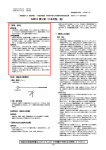
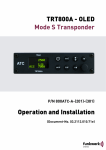
![U.S. Version [Last Updated on: Jun 13th, 2014]](http://vs1.manualzilla.com/store/data/005873845_1-0370c7761d3b42576ec2ae1fd24c9e75-150x150.png)
